.avif)
Hey there, I’m Vrushti Oza.
Over seven years ago, I stumbled into writing when I took some time off to figure out whether industrial or clinical psychology was my calling. Spoiler: I didn’t choose either. A simple freelance writing gig helped me realize that writing was my true calling. I found myself falling in love with the written word and its power to connect, inform, and inspire.
Since then, I’ve dedicated my career to writing, working across various industries and platforms. I’ve had the opportunity to tell brand stories in the form of blogs, social media content, brand films, and much more.
When I'm not working, you'll find me at the gym, or exploring restaurants in Mumbai (because that's where I live!) or cracking jokes with Bollywood references.
Writing wasn’t the path I planned, but it’s one I’m grateful to have found—and I can’t wait to see where it leads!
Feel free to connect with me on LinkedIn if you want to chat about writing, marketing, or anything in between.

ZoomInfo Alternatives: Top 5 ZoomInfo Competitors
ZoomInfo has cemented itself as one of the most well-known names in the sales tools & intelligence space. Recognized by G2 and Forrester as a category leader, it’s often the first stop for revenue teams exploring their stack, especially when comparing it to Apollo.
With its massive B2B database, real-time buyer intent data, AI-powered account intelligence, and seamless CRM integrations, ZoomInfo positions itself as more than just another data provider. It’s marketed as a full-stack growth engine for modern GTM teams.
TL;DR
- ZoomInfo is a leading sales intelligence platform with a massive B2B database and AI-driven insights.
- Businesses often look for a ZoomInfo alternative due to high costs, complex onboarding, or limited fit for smaller teams.
- Popular alternatives include Factors.AI, Apollo.io, UpLead, Lusha, Seamless.AI, and Hunter.io.
- Each platform offers unique strengths like verified data accuracy, affordability, or simplified workflows.
- Choosing the right tool depends on priorities such as budget, integrations, and data reliability.
- ZoomInfo works well for display advertising capabilities, company and contact database. However, Factors.ai, on the other hand, is purpose-built for LinkedIn and Google Ads, helping marketers optimize campaigns, improve ROI, and connect ad performance directly to pipeline.
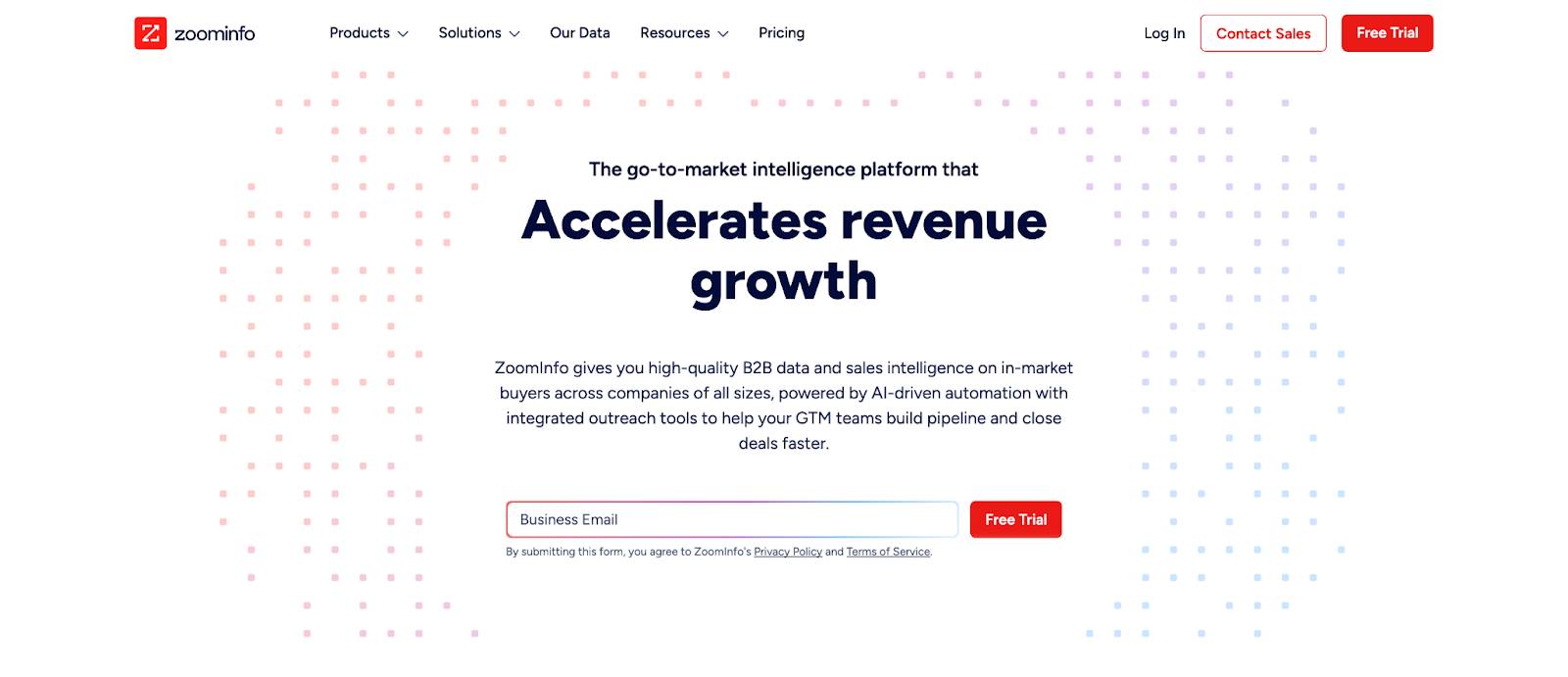
ZoomInfo’s Core Offerings
ZoomInfo positions itself as an all-in-one sales tools & intelligence platform, giving GTM teams the data and automation they need to identify, engage, and convert high-value accounts. Here’s what it brings to the table:
- Extensive B2B Database: Verified, accurate, and compliant company and contact information to expand your total addressable market (TAM) and connect with the right decision-makers.
- Buyer Intent Signals: Uses third-party intent data to yield insights into which accounts are actively researching solutions, so sales teams can prioritize outreach more effectively.
- AI-Powered Account Intelligence: Deeper visibility into target accounts with details like organizational changes, new stakeholders, and emerging pain points.
- Data Enrichment & Automation: Keep CRM records updated with fresh data, while automating workflows like lead routing, territory management, and follow-ups.
- Seamless Integrations: Out-of-the-box connections with leading platforms such as Salesforce, HubSpot, Outreach, and Marketo to align sales and marketing teams.
Trusted by 35,000+ businesses, ZoomInfo is often the first stop for teams comparing Apollo vs ZoomInfo or evaluating other ZoomInfo competitors. But despite its strong reputation, not every business finds it to be the perfect fit, which is why many start looking for a ZoomInfo alternative.
Why do people look for ZoomInfo Alternatives?
Let’s look at a few G2 reviews that highlight why some teams begin exploring ZoomInfo alternatives:

- Data inaccuracies: Some users warn that ZoomInfo’s buyer intent signals can produce false positives, flagging companies not actually in-market. They also note that both contact details and firmographic data (such as funding and growth indicators) may be outdated or inaccurate.

- Expensive: Organizations often find ZoomInfo expensive and its pricing structure opaque and users must contact sales to get a quote, making cost comparisons difficult.

While these reviews don’t negate ZoomInfo’s strengths but do show why many teams start searching for ZoomInfo competitors that align better with their size, budget, and support expectations.
ZoomInfo Pricing
ZoomInfo does not provide pricing publicly. Its plans are organized into Sales, Marketing, and Talent Solutions, and companies need to contact ZoomInfo for a personalized quote tailored to their requirements.
For a deeper breakdown of costs, add-ons, and user feedback on affordability, you can explore our detailed guide on ZoomInfo pricing.

What to look for in a ZoomInfo Alternative
When evaluating a ZoomInfo alternative, it’s important to step back and define what really matters for your sales intelligence stack. While ZoomInfo is known for its massive database and advanced features, not every team needs the same depth or the same price tag. Based on user feedback and industry comparisons, here are the key factors to consider:
- Data Accuracy & Coverage: ZoomInfo is praised for its breadth, but competitors often match or exceed its accuracy guarantees. Look for alternatives that keep data fresh, verified, and compliant across your target regions.
- Ease of Use & Onboarding: Some businesses find ZoomInfo’s setup and interface complex. If your team values simplicity, prioritize tools with faster onboarding and user-friendly dashboards.
- Pricing & Flexibility: One of the top reasons teams move away from ZoomInfo is cost. Check whether alternatives provide transparent pricing, flexible contracts, or credits that scale with your business size.
- Integrations & Workflow Fit: ZoomInfo integrates deeply with CRMs, but not every team uses advanced features. Evaluate whether alternatives offer the integrations you actually need without forcing you into unnecessary add-ons.
- Support & Transparency: User reviews often mention challenges with ZoomInfo’s support and billing. Consider how responsive and reliable an alternative’s support team is, and whether their sales process feels transparent.
The right ZoomInfo alternative should balance accuracy, affordability, and usability while fitting neatly into your team’s existing workflows.
Now that we’ve broken down almost everything about ZoomInfo, let’s take a closer look at the top platforms that often come up as ZoomInfo competitors and why they’re worth considering as an alternative.
Apollo.io
When people compare Apollo vs ZoomInfo, the difference often comes down to cost, usability, and stack consolidation. Apollo positions itself as an end-to-end AI-powered sales platform with a vast B2B database, built-in engagement tools, and automation features. Trusted by 500,000+ businesses, it’s seen as a leaner, cost-effective alternative to larger players like ZoomInfo.
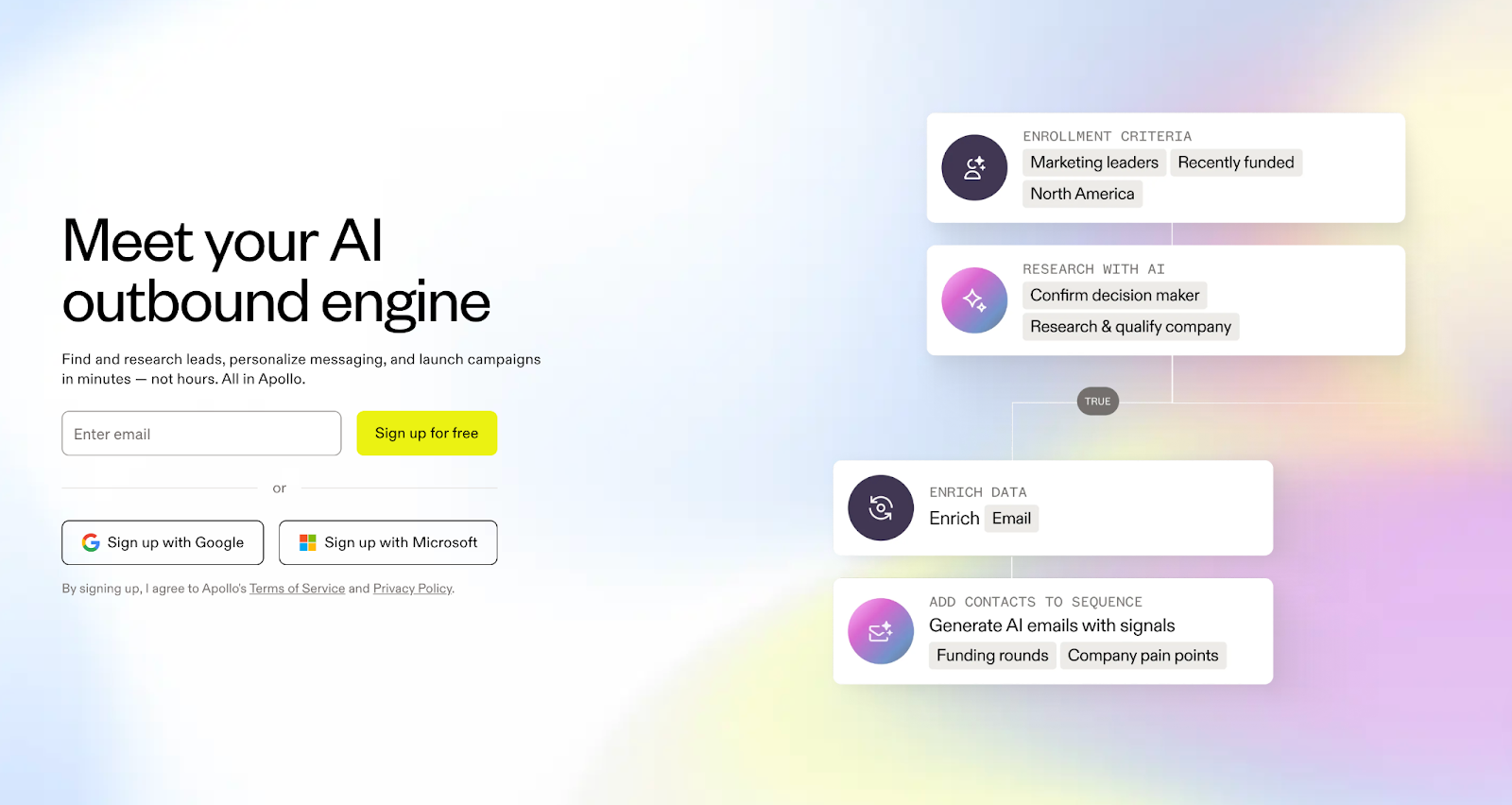
Core Offerings
- B2B Database: Access to 210M+ contacts and 35M+ companies, powered by Apollo’s Living Data Network.
- Pipeline Builder: AI-driven workflows to identify leads, build pipeline faster, and automate prospecting tasks.
- Call Assistant: Meeting scheduling, AI call insights, transcription, and automated follow-ups.
- Data Enrichment: Enrich CRM records with 30+ data points, ensuring freshness and accuracy across systems.
- Go-To-Market Platform: Unified hub for deal management, sales engagement, and CRM integrations.
- Integrations & Extensions: Native integrations with Salesforce, HubSpot, Outreach, and a Chrome extension for prospecting anywhere.
What it lacks
- Some customers report that Apollo has automatically migrated accounts to new plan variants without prior notice, altering contracted terms and creating uncertainty around pricing transparency. Source: G2
- Users mention that Salesforce (SFDC) integration is difficult to set up and maintain, with support often outsourced and unable to resolve tickets effectively. Source: G2
- Others note that Apollo’s intent data doesn’t always deliver reliable results, especially in metro markets. Source: G2
Pricing
Apollo keeps its pricing fairly straightforward. It offers a free trial and transparent tiers designed to scale as your prospecting needs grow. Here’s a quick look at what each plan includes and how they compare.

UpLead
UpLead positions itself as a lean, user-friendly prospecting platform built around real-time verified B2B contact data. Trusted by 4,000+ customers, it offers 95% data accuracy guarantees and aims to deliver reliable, cost-effective lead generation without unnecessary feature bloat.

Core Offerings
- Real-time Verified Data: A 95% accuracy guarantee with instant email verification so sales teams avoid wasted outreach.
- Extensive Prospecting Filters: 50+ search filters to build laser-targeted lead lists tailored to your ICP.
- Mobile Numbers & Direct Dials: Access verified mobile and direct dial contacts to accelerate outreach.
- Intent Data: Identify and prioritize prospects actively researching solutions in your space.
- Technographics: Insights into 16K+ technology data points for sharper segmentation and targeting.
- Data Enrichment & Bulk Lookup: Sync thousands of records into your CRM with complete, updated data.
- Seamless Integrations: Connect directly with popular CRMs and outreach tools to streamline prospecting workflows.
What it lacks
While UpLead delivers strong accuracy guarantees, some users report issues with reliability and usability at scale:
- The database doesn’t always have full coverage for niche accounts or industries, leaving gaps in prospecting lists. source: G2
- Missing or inaccurate phone numbers have been flagged as a recurring frustration by sales teams. source: G2.
- Credits management can feel restrictive, with some users noting difficulty in accessing pre-purchased leads without keeping a paid plan active. Source: G2.
Pricing
UpLead keeps pricing simple and transparent, and you can start with a free trial to test the waters. From there, paid tiers scale with your prospecting needs. Here’s how the plans break down.

Lusha
Lusha markets itself as a sales intelligence platform designed to make prospecting faster with real-time verified contacts, buying signals, and GDPR/CCPA-certified compliance. With over 280M verified contacts and strong integrations, it appeals to sales, marketing, and recruiting teams that want a lighter, more affordable option than enterprise platforms.
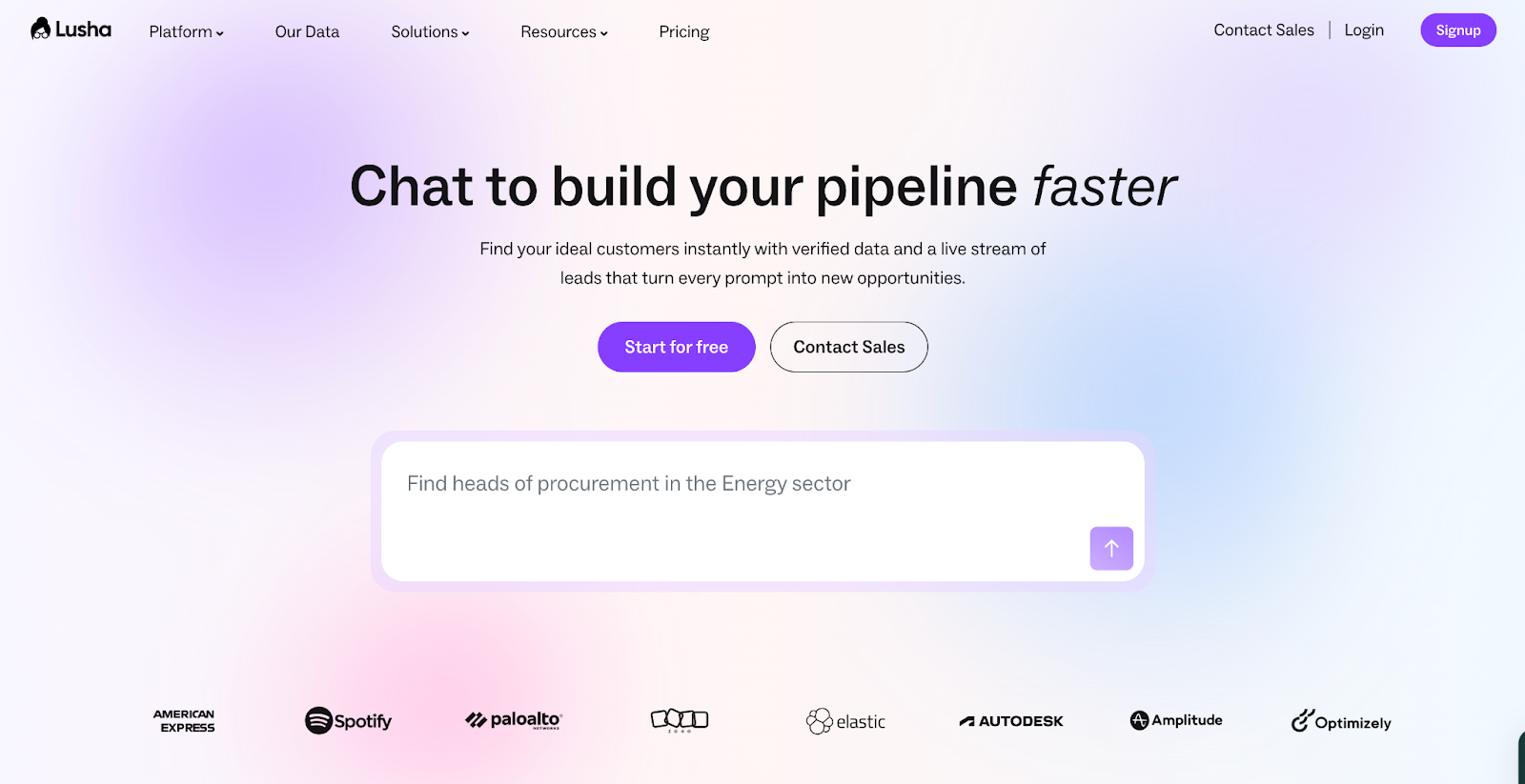
Core offerings
- Verified B2B Database: Access 280M+ decision-maker contacts with validated phone numbers and emails.
- High Data Accuracy: 85% phone accuracy and 98% email deliverability to reduce wasted outreach.
- Buyer Intelligence: Live intent signals help prioritize prospects who are actively looking to buy.
- Compliance & Security: GDPR, CCPA, ISO 27001, and SOC 2 Type II certifications provide data privacy confidence.
- Integrations & API: Enrich your CRM, sync prospect lists, and build workflows with Salesforce, HubSpot, Outreach, Slack, Zapier, and more.
- Chrome Extension: Find and capture verified contacts directly from LinkedIn and company websites.
What it lacks
Despite its strengths, user reviews suggest some recurring challenges:
- Cancellation and billing can feel restrictive, with customers noting difficulty in stopping auto-renewals or removing payment details. Source: G2
- Data coverage and quality don’t always match expectations, with reports of missing or inaccurate records. Source: G2
- Customer support and product reliability have been flagged as inconsistent, with some users citing bugs and slow resolution times. Source: G2
Pricing
Lusha’s pricing is built around a credit-based model, meaning you only pay for what you actually use. Each plan gives you a set number of credits that can be used to unlock verified contact and company data. You can start with a free plan to test the platform, then move up to paid tiers as your prospecting scales. Here’s a quick breakdown of how each plan works.

Seamless.AI
Seamless.AI positions itself as the #1 AI-powered real-time B2B contact data platform. It helps sales, marketing, and recruiting teams find verified contact info for over 1.3B+ contacts and 121M+ companies in seconds. With its Chrome extension and integrations with major CRMs like Salesforce, HubSpot, and Outreach, Seamless.AI promises to make prospecting faster, easier, and more accurate.
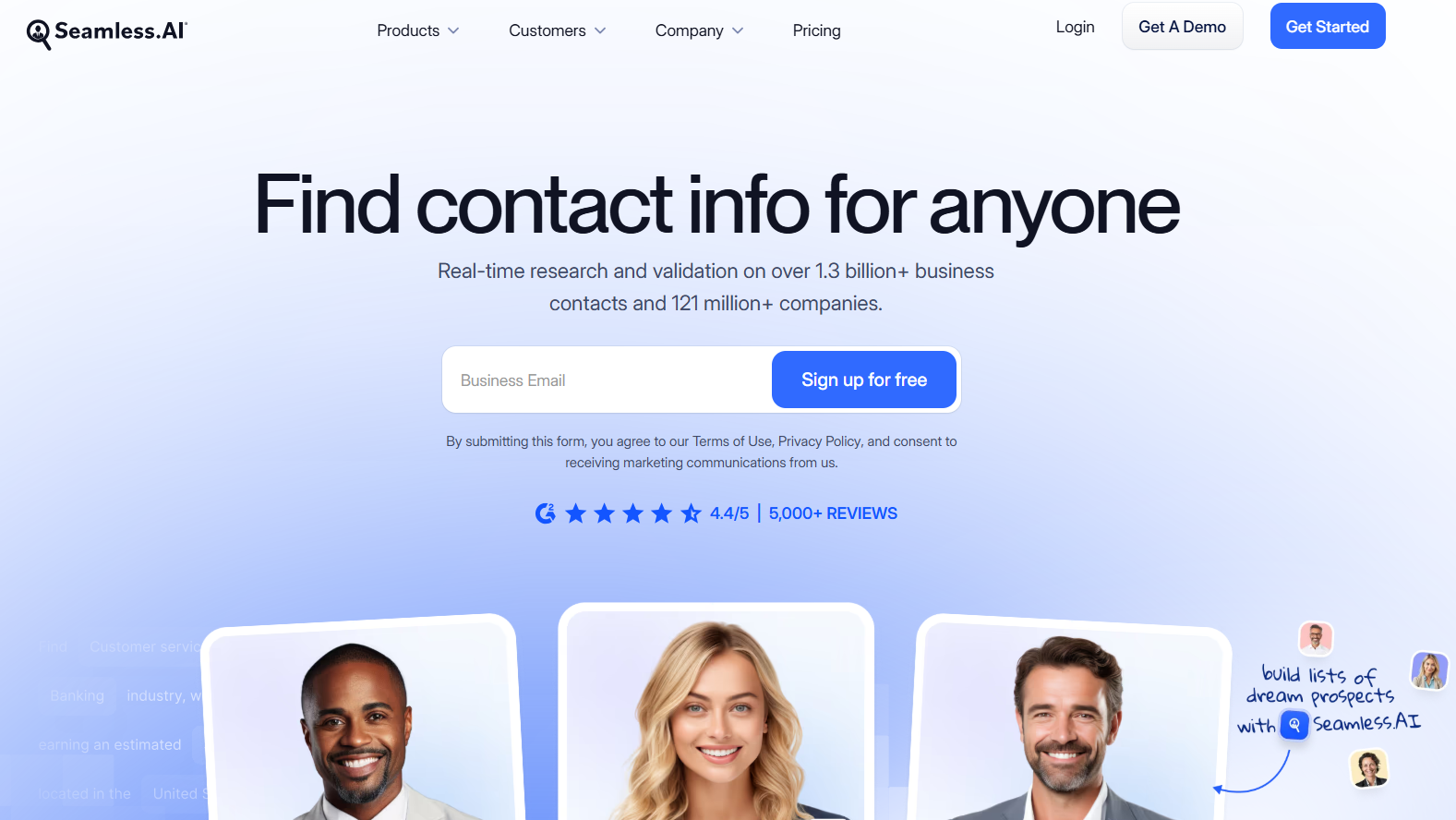
Core offerings
- Real-Time Prospecting: Access 1.3B+ contact records and 121M+ company profiles with verified email addresses and phone numbers.
- AI-Powered Research: Automatically research, validate, and enrich contact details for higher accuracy.
- Buyer Intent Data: Identify prospects who are ready to buy and prioritize your outreach.
- Job Change Tracking: Get notified when key prospects change roles to re-engage or upsell.
- Data Enrichment & CRM Sync: Enrich your CRM records and eliminate data decay with one-click integrations.
- Chrome Extension: Find emails and phone numbers directly from LinkedIn or websites.
What it lacks
- Aggressive Auto-Renewal & Billing Complaints: Multiple users reported being charged thousands of dollars for renewals without receiving prior notification, with no refunds issued despite legal requirements. Source: G2
- Data Accuracy Issues: Users frequently encounter outdated or inaccurate contact data (bounced emails, disconnected numbers), reducing the usable match rate to as low as 25%. Source: G2
- Persistent Sales Outreach & Rigid Contracts: Some reviewers noted excessive follow-ups from the sales team and contracts that are hard to exit without months of prior notice. Source: G2
Pricing
Seamless.AI does not list exact pricing publicly; plans are customized based on team size, desired features, and add-ons, and businesses need to contact sales for a personalized quote.

Hunter.io
Hunter.io is a popular email outreach and lead-generation platform trusted by 6M+ users worldwide. It helps businesses find, verify, and connect with the right prospects by providing accurate, GDPR-compliant contact data, all in one simple dashboard.
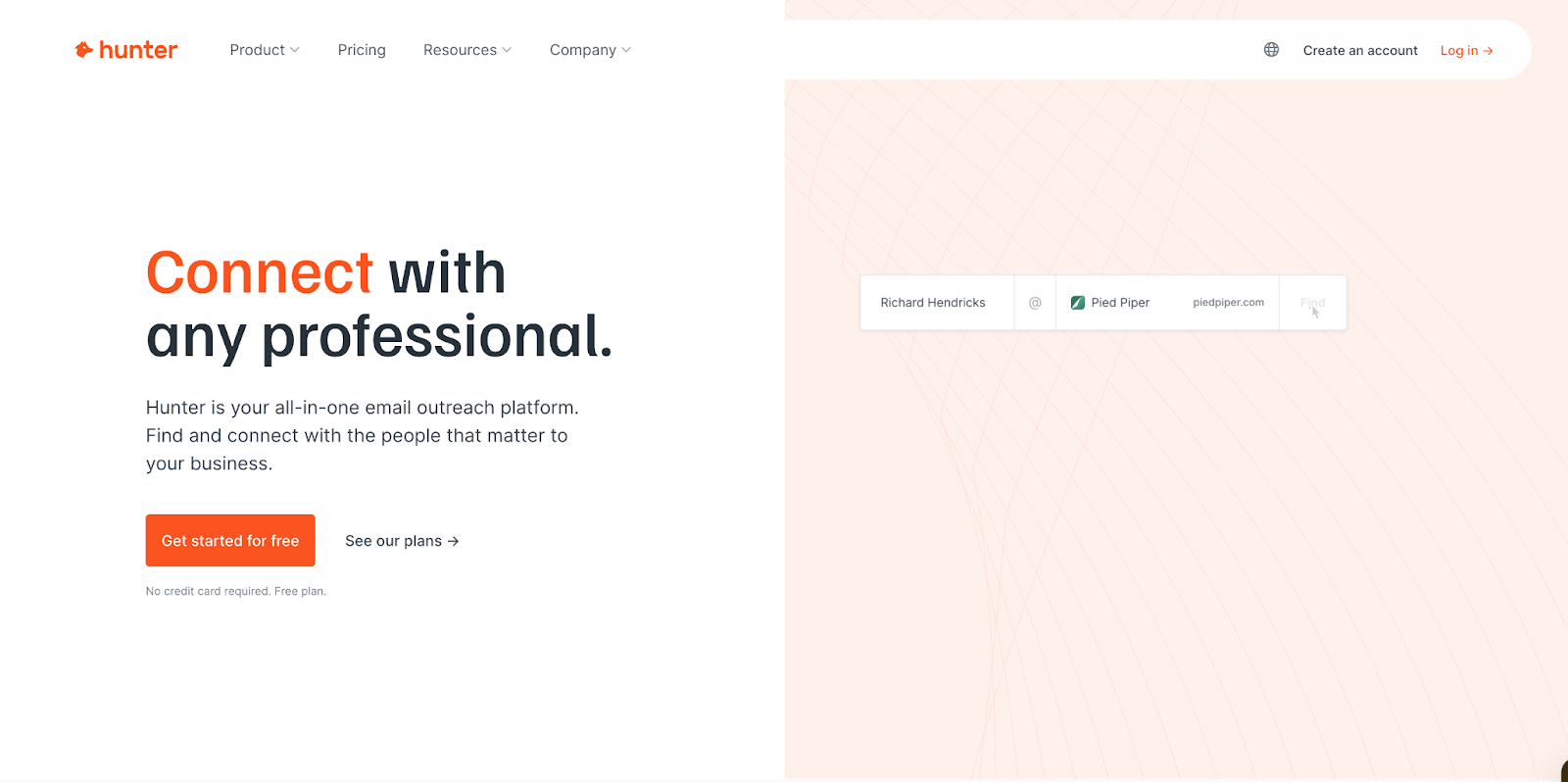
Core offerings
- Domain Search: Find verified email addresses associated with any company name or website.
- Email Finder: Type a name and instantly get a validated email address with a high match rate.
- Email Verifier: Eliminate bounces and protect sender reputation with reliable verification.
- Campaigns: Build, personalize, and schedule cold email campaigns with automated follow-ups.
- Integrations & API: Connect with Google Sheets, CRMs, Zapier, or use their API for large-scale data needs.
- Browser Extensions: Find emails directly from websites you visit.
What it lacks
- Some users report reduced data availability after recent updates, making it harder to justify the cost. Source: G2
- Email verification is expensive compared to competitors, with limited credits for the price. Source: G2
- Certain websites block Hunter’s crawler, resulting in errors or missed data even when correct. Source: G2
Pricing
Hunter.io keeps things simple with transparent, credit-based pricing, and even offers a free plan so you can test it out before committing. Each plan gives you a set number of searches and verifications, scaling up as your outreach grows. Here’s how the pricing breaks down.
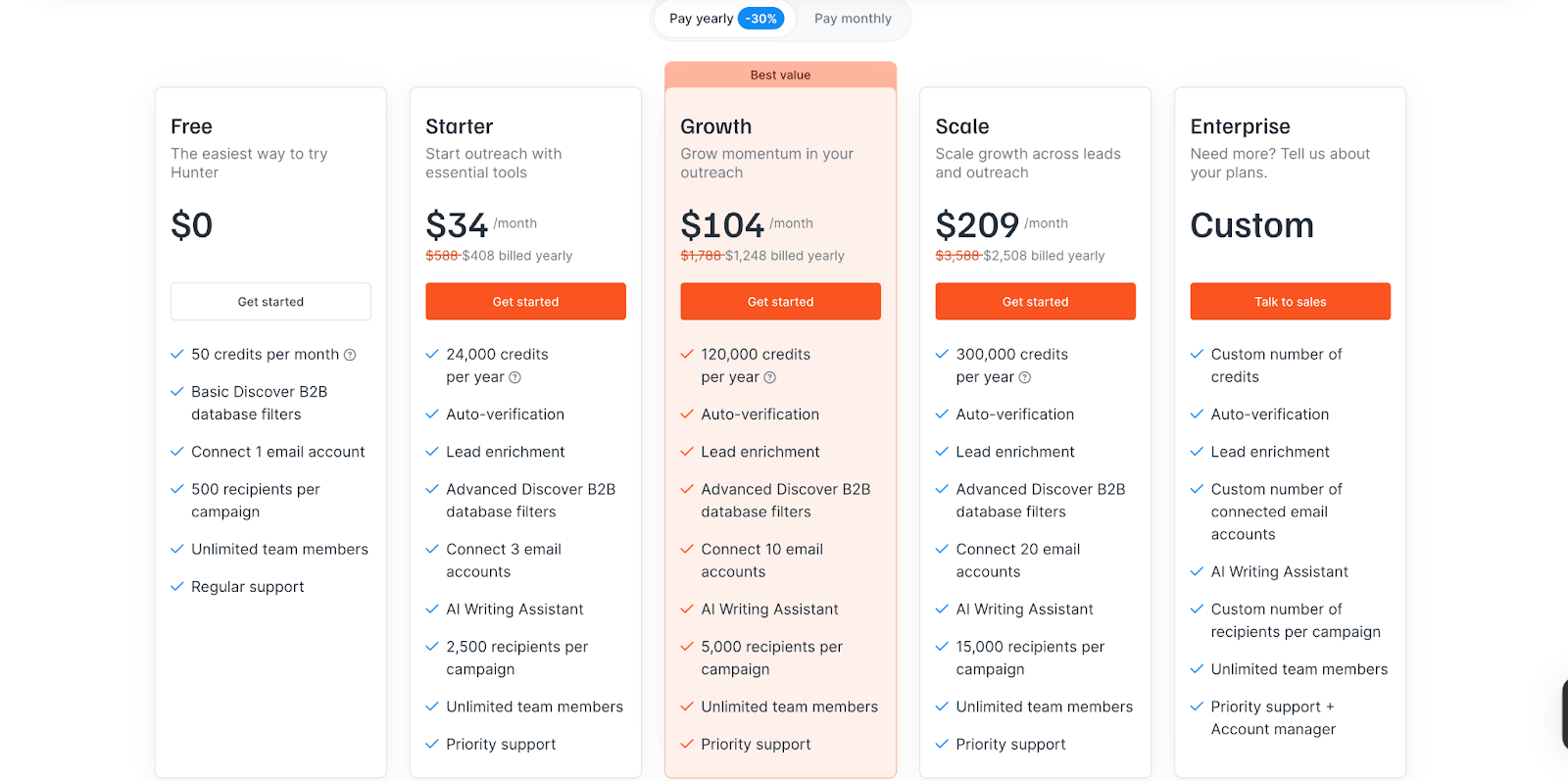
PS: The limitations we’ve shared are based on a limited number of user reviews and personal experiences. They don’t tell the full story of these tools. In fact, many users on G2 and other platforms have praised them for their reliability and value. We encourage you to explore those reviews too. Our goal here is to provide you with a balanced view, helping you make a more informed decision.
Looking for a better alternative to ZoomInfo? Here’s why many teams choose Factors.ai instead
While ZoomInfo and its alternatives excel at data accuracy and prospecting, today’s GTM teams need more than just contact databases. They need to know who’s ready to buy, when they’re ready, and what’s actually driving pipeline. That’s where Factors.ai vs ZoomInfo becomes an important comparison, helping revenue teams see how Factors.ai goes beyond static intent data to deliver actionable GTM intelligence.
Factors.ai in action:
- GTM Intelligence: AI agents that surface deep account research, revive closed-lost opportunities, and notify your reps the moment buyers show intent.
- Milestones & Account 360: Complete funnel visibility with unified reporting on every marketing and sales touchpoint.
- AI Alerts & Ad Syncs: Real-time triggers and seamless Google/LinkedIn ad syncs to engage the right audience at the right time.
- Account 360: A unified, sortable view of every sales and marketing touchpoint for an account — from ads and content engagement to sales outreach. Aligns GTM teams, improves targeting, and ensures no high-intent account slips through the cracks.
- LinkedIn AdPilot: 2X your LinkedIn Ads ROI with Factors' LinkedIn AdPilot. Sync high-intent audiences, controlling ad impressions, automating campaigns, and measuring true ROI with view-through attribution.
- Google AdPilot: Run better ads on Google with Google AdPilot. Google CAPI sends richer, more accurate conversion signals to Google Ads by combining click-level data, firmographics, and engagement scoring. Helps Google optimize for high-value accounts instead of low-quality leads. Google's Audience Sync enables advanced audience targeting for Google Ads. Retarget only ICP-fit accounts, suppress wasted clicks from job seekers or competitors, expand into expensive keywords with control, run buyer-stage–specific campaigns, and keep audiences fresh with daily automated updates.
- Account & Contact Scoring: Prioritize outreach with scores based on ICP fit, funnel stage, and intent intensity, so sales focuses on accounts most likely to convert.
- Customer Journey Timelines: See exactly what actions a buyer has taken across your website, ads, product, and CRM — all in chronological order.
- AI-Driven Contact Insights: Agents that surface the right contacts within each account, generate personalized outreach insights, and monitor deal progress.
- Dynamic Ad Activation: Sync audiences to LinkedIn and Google Ads in real time for budget-efficient targeting, in-funnel retargeting, and precise ABM campaigns.
- Slack/MS Teams Alerts: Instant notifications for high-intent actions such as demo page visits, security document views, or pricing page revisits.
- Multi-threading & Buying Group Identification: Identify and engage multiple decision-makers in a target account to reduce deal risk and avoid single-threaded opportunities.
Want a closer look at how Factors.ai helps GTM teams drive predictable growth? Book a demo with us today to learn more.
Choose the right ZoomInfo alternative (leave the guesswork out of the door)
ZoomInfo remains one of the most powerful names in the sales intelligence space but it’s not a one-size-fits-all solution. Whether it’s cost, contract flexibility, or the need for more user-friendly workflows, there are plenty of reasons why revenue teams explore alternatives.
The good news? The market is full of capable competitors like Apollo.io, UpLead, Lusha, Seamless.AI, and Hunter.io each with its own strengths. The right choice depends on your priorities: budget, data accuracy, feature depth, or ease of integration.
And if you’re looking to go beyond just contact lists and truly understand buyer intent, campaign performance, and revenue impact, a platform like Factors.ai can help you tie everything together.
Your next step? Review your team’s GTM goals, compare the options we’ve listed, and pick the platform that fits your business needs not just today, but for the long run.
FAQs on ZoomInfo Alternatives and Competitors
Q. Is ZoomInfo the only sales intelligence platform for enterprise teams?
A. No, while ZoomInfo is widely recognized, there are multiple competitors that serve enterprises effectively. Tools like Cognism and Apollo.io now offer enterprise-level data, compliance, and integrations at competitive prices.
Q. Do ZoomInfo alternatives provide compliance with GDPR or CCPA?
A. Yes, many ZoomInfo alternatives emphasize compliance with international data regulations. This makes them attractive for global businesses that need legally sound, privacy-first prospecting solutions.
Q. Can smaller startups benefit more from ZoomInfo alternatives?
A. Absolutely. Many ZoomInfo alternatives offer flexible pricing, smaller data packages, and easier onboarding.
Q. How do ZoomInfo alternatives handle integrations with CRMs and sales tools?
A. Most leading competitors provide direct integrations with Salesforce, HubSpot, and outreach tools. Some, like Apollo.io, even include built-in engagement features, reducing the need for additional software in the stack.
Q. Are ZoomInfo alternatives reliable for global prospecting?
A. Yes, but coverage varies. Some platforms focus on broad international databases, while others excel in specific regions. It’s best to match the provider’s strengths with your target markets.
Q. ZoomInfo-WebSights: has anyone had success using it?
A. Users say it’s helpful for seeing which companies visited, but frustrating when you need person-level IDs; workflows and page filters help, but it’s still company-level.
Q. What’s the difference between ZoomInfo WebSights and other website visitor tools?
A. WebSights maps visits to company profiles via IP and can push data to GA/ads; other tools claim person-level resolution, evaluate legality and match rates.
Q. Any luck with ZoomInfo’s intent data?
A. Mixed: some report real-time topics and better accuracy than other tools; others cite noise, test against your ICP.
Q. Is ZoomInfo worth $14k–$30k+ a year?
A. Opinions vary; many call it pricey and recommend proving ROI first or considering alternatives if you don’t need massive contact coverage.
Q. Is ZoomInfo still the best for mobile numbers and data quality?
A. Many sellers say ZoomInfo leads on US mobile coverage; accuracy still varies by niche and region.
Q. How much does ZoomInfo actually cost?
A. Community threads consistently cite opaque pricing; ballparks often start around $15k+/year depending on seats/credits.
Q. Any real user takes on Factors.ai?
A. Entrepreneurs and marketers mention using Factors.ai to unmask site traffic and find warm leads, results vary by traffic quality.
Q. Best alternative if I want analytics/attribution vs a big database?
A. Threads comparing analytics platforms (e.g., Dreamdata vs Factors) suggest choosing based on journey analytics & attribution needs over raw contacts.
Q. Are big lead databases still working in 2025?
A. Some marketers argue reply rates are declining with giant databases and suggest pairing first-party signals + identity instead.
.png)
LinkedIn’s Company Intelligence API: Prove Full-Funnel Impact with Factors
If you run B2B demand gen, you already know that LinkedIn is where your buyers research, react, and rally a buying group. And for years, you could measure the paid side of that story, while organic engagement lived in the dark. That changes with our integration of LinkedIn’s Company Intelligence API.
As an official LinkedIn B2B Attribution & Analytics Marketing Partner, Factors now bridges the gap between paid and organic engagement, giving marketers a complete, unified view of buyer behavior on LinkedIn.
This capability surfaces company-level engagement across paid and organic touchpoints, so you can connect every LinkedIn interaction to pipeline and revenue accurately, transparently, and in a way that sales can immediately act on.
TL;DR
- LinkedIn’s Company Intelligence API surfaces company-level engagement from paid + organic, so you can finally see LinkedIn’s full-funnel impact.
- You get attribution that reflects how buying groups actually buy, not just last-click or one user’s activity.
- Plug it into Factors.ai to stitch signals into buyer timelines, map them to pipeline/CRM, and activate (alerts, routing, synced audiences) without CSVs.
- Here’s what you can do: Connect the integration → get insights from paid + organic efforts → sync audiences to LinkedIn Campaign Manager → turn on seller alerts → report at the company level.
- Measure success by looking at the influenced pipeline, conversion lift vs. non-engaged companies, time from first LinkedIn touch → first meeting/opportunity, and CPA as budget shifts to proven touchpoints.
What is LinkedIn’s Company Intelligence API?
A way to capture rich, company-level engagement across paid and organic LinkedIn touchpoints such as: Paid Engagements, Organic Engagements, Organic Impressions, Paid Impressions, Paid Clicks and Paid Leads.
With LinkedIn’s Company Intelligence now integrated into Factors reports you can see how companies actually interact with your brand, attribute influence more accurately, and act on buying signals while interest is high.
See how it works in this video.
“LinkedIn Ads is core to our marketing strategy, and the integration between Factors and LinkedIn gives us clear visibility into how both organic and paid touchpoints impact pipeline. It gives us confidence in deciding who to target and which campaigns should get additional investment."
- Bhargav Chandrababu, Director of Digital Marketing, Sprinklr
💡What’s new
- Organic signals: Company-level organic impressions and organic engagement, alongside paid impressions, clicks, and leads.
- Here’s why you should care: Now, you can capture view-through influence (who saw content before acting elsewhere) and early buying-group interest that last-click reports miss.
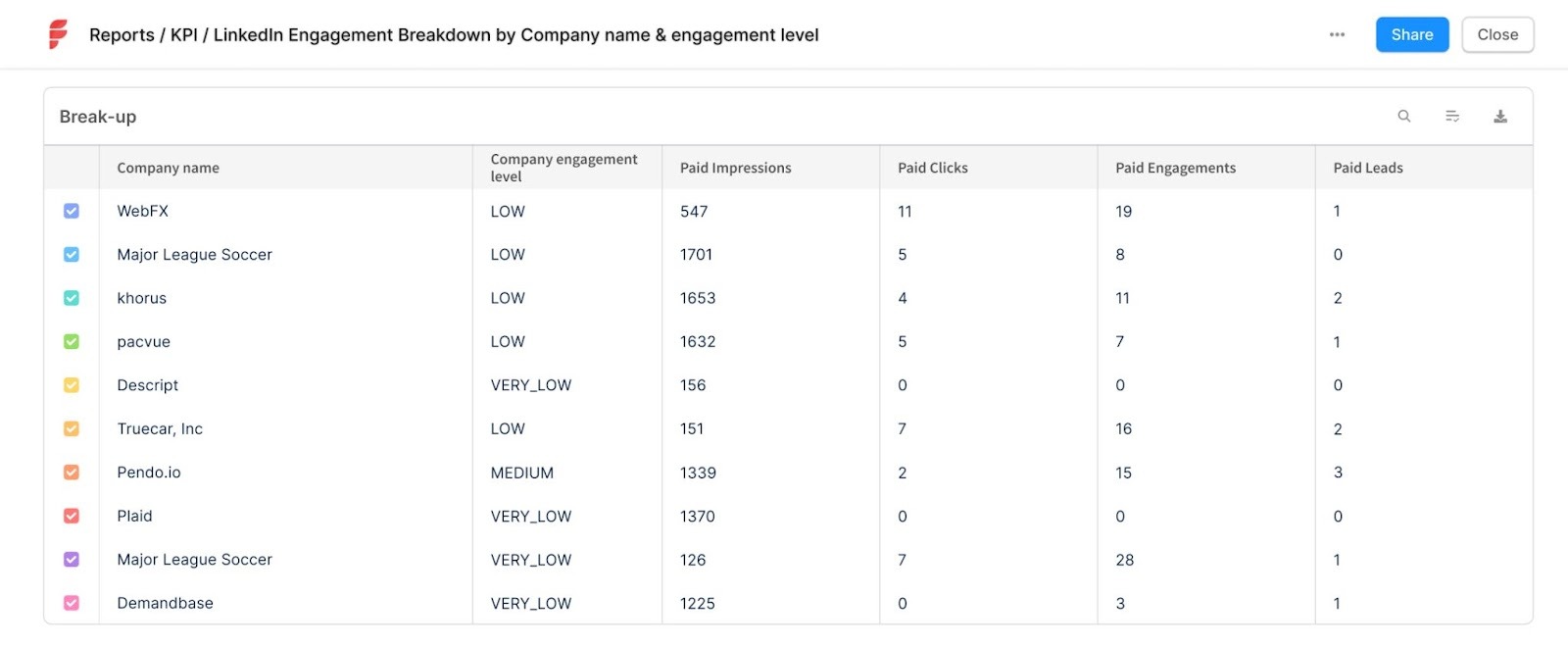
LinkedIn Company Intelligence API + Factors.AI: Get the best of both worlds
- Full-funnel visibility across paid and organic
The gap today: Paid is measurable; organic often disappears into the dark funnel.
What you get now: A continuous view of how compaines interact with your ads and posts throughout the journey.
Why it matters:
- Narrative clarity: See how a post sparks attention, an ad reinforces the message, and a website visit pushes the deal forward, mapped on your customer journey timeline with other intent signals.
See the full journey with Factors:
Company-level signals across paid & organic LinkedIn, stitched into your account timelines in Factors.
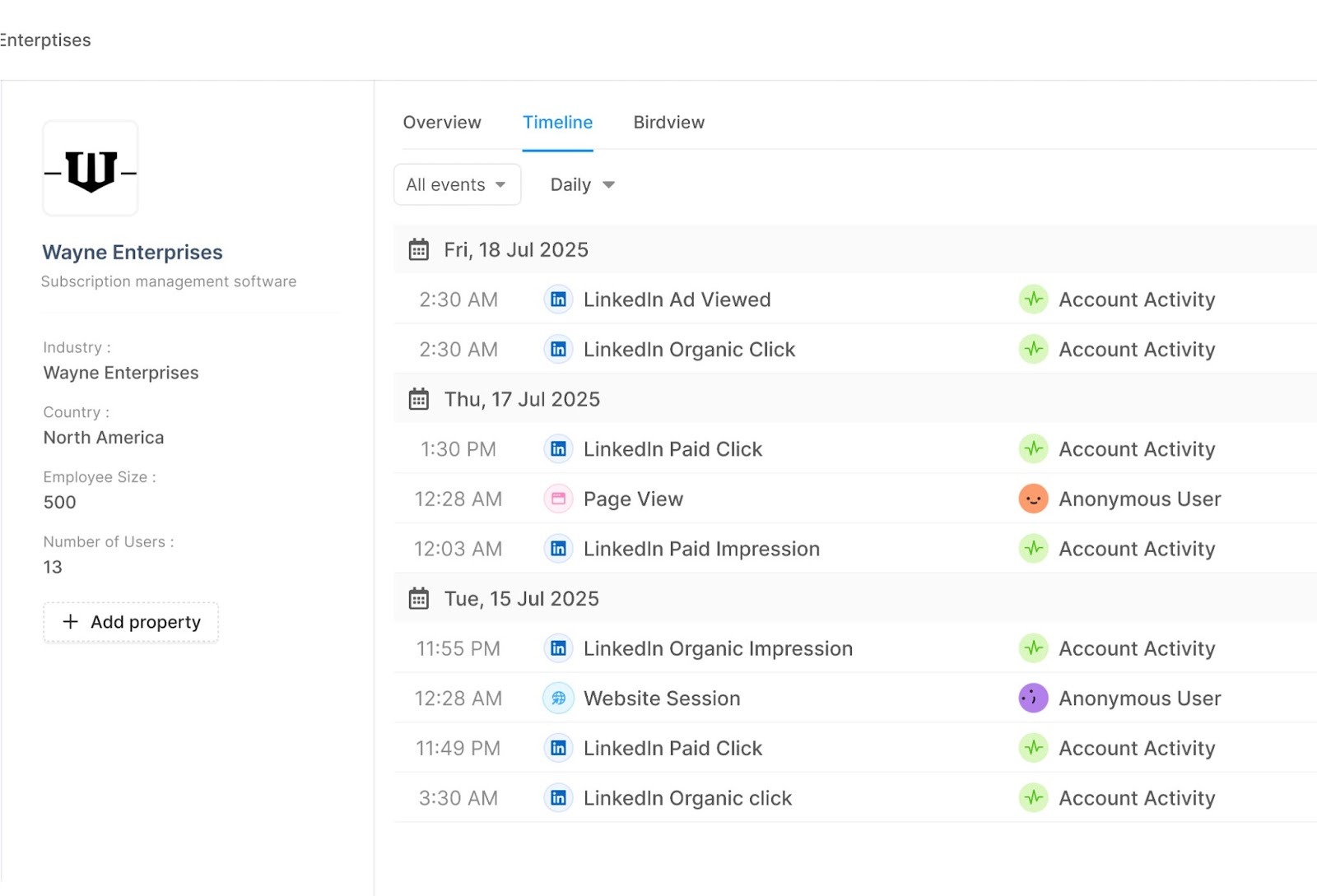
- Attribution that matches how businesses really buy
The gap today: LinkedIn ads work like billboards on your buyers’ commute. Thousands see them, some engage, and a few eventually fill a form. But last-click reports only credit the form fill, ignoring the view-through influence that actually drove the action.
What you get now: company-level engagement from both paid and organic LinkedIn, tied to pipeline.
Why it matters:
- Credit the real influence: Organic interactions that happen before a form fill now show up (and get counted.)
- Invest smarter: Know which LinkedIn touches drive meetings, opps, and revenue.
Prove attribution with Factors:
Connect company-level ad + organic activity to meetings, MQLs, SQLs, Opportunities, and Revenue.
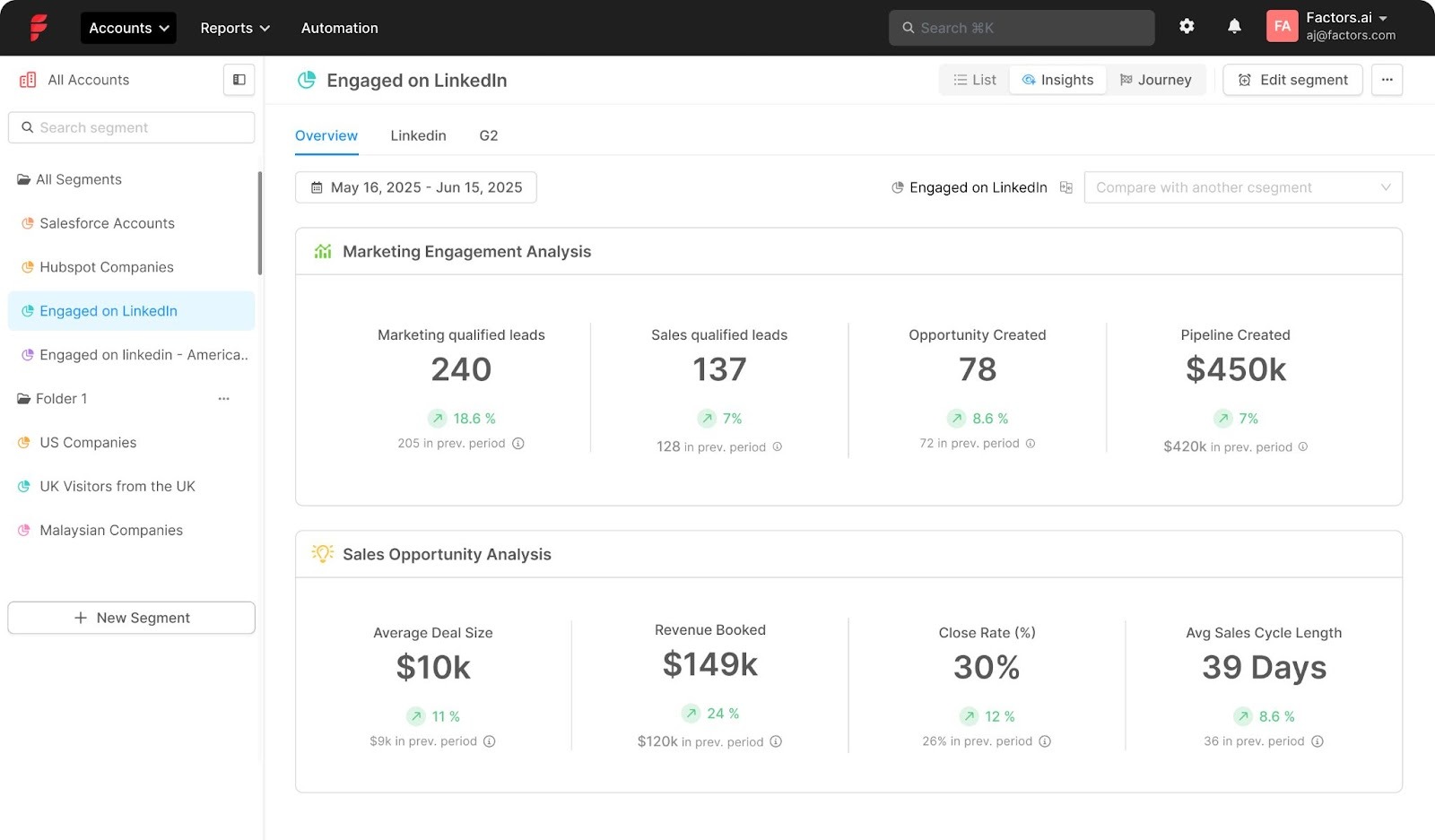
- Audience automation that compounds performance
The gap today: Most campaigns run on broad targeting or weak signals like web visits and form fills. Organic engagement never makes it into your targeting, and when it does, it’s through outdated CSV uploads.
What you get now: Build audiences from both organic + paid LinkedIn engagement and sync them straight into Campaign Manager. Audiences stay fresh automatically, with sales alerts and workflows triggered in real time while interest is high.
Why it matters:
- Intent-based precision: Target companies showing real buying signals across ads and organic, not just broad demographics.
- Persistent relevance: Audiences update as engagement changes, so targeting stays aligned with buyer activity.
- Less manual work: No more CSV uploads or stale lists. Everything updates in Factors’ dashboard automatically.
- Faster pipeline: Reps focus on companies already warming up on LinkedIn, moving deals quicker.
Run intent-based campaigns with Factors:
Prioritize high-intent companies, trigger sales alerts, and auto-sync audiences, no manual work required.
The proof is in the pudding: Here’s what teams have seen in tests
These gains result from combining organic and paid signals, acting on them through prioritization, audience synchronization, and coordinated outreach. Early results across show:
- Up to 3.6x more companies reached
- Up to 4x more companies engaged
- 75% more MQLs influenced
- 96% more SQLs influenced
- 43% lower CPA
All in all, the takeaway is:
You’ll identify far more of the companies seeing your content (reach) and interacting with it (engagement), not just the small slice that click and convert immediately.
In a nutshell…
LinkedIn surfaces the signals; Factors turns them into pipeline, clearer attribution, smarter spend, faster sales.
FAQs
Q1: What exactly does the Company Intelligence API do?
It tracks company-level engagement across paid and organic LinkedIn touchpoints, so you can see how companiess interact with your brand, attribute influence more accurately, and act when intent spikes.
Q. How is this different from measuring ads alone?
A. Ads tell half the story. This brings organic engagement into view so you capture early research behavior, attribute influence beyond last-click, and act sooner.
Q. What day-one use cases should I set up?
A. KPI reporting at the company level, journey timelines, synced audiences in LinkedIn Campaign Manager, and sales alerts for spikes in combined engagement.
Q. Will this replace my current attribution model?
A. No, it enhances your model with better inputs: company-level LinkedIn engagement (paid + organic) that plugs into your existing reporting.
Q. What outcomes should I expect to track?
A. More engaged companies, more influenced MQL/SQL, and improved CPA as you shift spend toward touchpoints that move companies forward.
Q. How do you match companies between LinkedIn Ads and HubSpot/Salesforce?
A. We match companies by comparing their website domains in LinkedIn and your CRM.
.png)
Factors vs Lead Forensics: Which alternative is best for B2B teams?
If you’re reading this, chances are you’ve asked yourself: “Who’s actually visiting my website, and how do I do something about it?” That’s the problem tools like Lead Forensics were built to solve. They show you the businesses landing on your site and what they looked at. Helpful, yes, but in today’s revenue game, visitor visibility alone doesn’t win deals.
This guide explores Factors as a Lead Forensics alternative for B2B teams evaluating visitor identification and demand generation platforms. It highlights what each product does well, where their limitations lie, and which option best aligns with your current stage of growth.
Lead Forensics delivers on its promise of clear visitor visibility, making it a strong fit for teams testing outbound plays. But for companies that need to not only identify traffic but also enrich, score, activate, and attribute it back to pipeline, Factors positions itself as an end-to-end B2B demand generation platform.
In the sections ahead, we’ll compare both platforms across features, pricing, compliance, onboarding, analytics, and ad activation, giving you the clarity to pick the right fit for your GTM motion.
Factors vs Lead Forensics: Features and Functionality
| Feature | Factors | Lead Forensics |
|---|---|---|
| Primary Goal | End-to-end demand generation: identify, prioritize, activate, and attribute | Identify anonymous website visitors and generate contactable leads |
| Strengths | Multi-source intent signals, account scoring, ad activation, attribution | Simple dashboards, visitor visibility, CRM integrations, easy outbound starter |
| Ideal Team Profile | Revenue teams needing full-funnel GTM execution and ROI accountability | Early-stage teams testing outbound flows, focusing on top-of-funnel visibility |
| Activation | Native sync with LinkedIn & Google Ads in real time | Manual exports or Zapier for ads |
| Analytics | Full-funnel attribution, conversion paths, drop-off diagnostics | Visitor counts, page-level insights |
| Support Model | CSM + Slack/MS Teams, white-glove onboarding, optional GTM Engineering | Dedicated CSM, phone/email/chat, knowledge base |
Most tools in this category stop at showing you a company name and a list of page visits. That’s the baseline. What actually moves the needle is what you can do with that information, and how far the platform can take you beyond basic visibility.
Factors
Factors is an end-to-end B2B demand generation platform. Beyond visitor identification, it consolidates multiple intent signals and integrates them into GTM workflows.
Now, moving to visitor identification, Factors not only tells you who’s visiting your site; it stitches that data together with signals from your CRM, ad platforms, product usage, review sites, and more, then turns it into action. Whether that means scoring accounts, triggering timely outreach, syncing LinkedIn audiences, or enriching contacts, every step is unified and real-time.
Key Features:
- Account Identification & Intent
- Visitor Identification: Identify up to 75% of anonymous visitors using sequential enrichment from providers like 6sense, Clearbit, and Demandbase.
- Custom Intent Models: Combine website activity, CRM stages, product usage, ad clicks, and even G2 intent signals to create precise buying intent models.
- Account & Contact Scoring: Prioritize outreach based on scores that reflect ICP fit, funnel stage, and intent intensity.
- Multi-threading & Buying Group Identification: Map and engage multiple decision-makers to avoid single-threaded risks.
- Analytics & Attribution
- Milestones: Funnel stage analytics to pinpoint the content, actions, and campaigns driving progression from MQL to SQL and beyond.
- Customer Journey Timelines: See every action a buyer has taken across web, ads, product, and CRM in order.
- Account 360: A unified, sortable view of every sales and marketing touchpoint, ads, content engagement, and sales outreach.
- AI-Powered GTM Execution
- AI Agents: Surface the most relevant contacts, score them, and generate sales-ready outreach insights automatically.
- AI Alerts: Real-time, high-context alerts for form-fill drop-offs, post-demo browsing, and other high-intent actions.
- GTM Engineering: AI Agents and GTM services that turn intent into revenue, from real-time alerts to closed-lost reactivation and post-meeting engagement tracking.
- AI Agents: Surface the most relevant contacts, score them, and generate sales-ready outreach insights automatically.
- Ad Activation & Retargeting
- Dynamic Ad Activation: Sync audiences to LinkedIn and Google Ads in real time for budget-efficient targeting and precise ABM campaigns.
- Google Audience Sync: Retarget ICP-fit accounts, suppress irrelevant clicks, and run buyer-stage–specific campaigns with automated updates.
- Google CAPI: Send richer conversion signals to Google Ads using combined click-level data, firmographics, and engagement scoring.
- Collaboration & Alerts
- Slack/MS Teams Alerts: Receive instant notifications for actions like demo page visits or pricing page revisits.
- Automated Workflows: Push buying signals directly to Slack, your CRM, ad audiences, and outreach tools for instant follow-up.
- Factors shifts your GTM team from reactive to orchestrated, moving seamlessly from 'unknown visit' to 'qualified meeting' without manual list building or human bottlenecks.

Lead Forensics
Now, Lead Forensics. It focuses on a clear, singular motion: take anonymous visits and turn them into named companies your team can contact. It uses reverse IP lookup as its core identification method, then layers in contact data from its internal database to give sales teams a starting point. For organizations that want a straightforward “see who’s on the site and reach out” workflow, it delivers exactly that.
Here’s what that looks like:
- Identify website visitors via reverse IP lookup and match them against Lead Forensics’ proprietary contact database
- Access company profiles with basic firmographic details like industry, size, and location
- View page-by-page visit history to understand what content a visitor engaged with
- Export identified companies and contacts into CRM or email tools for manual follow-up
- Trigger simple outreach workflows based on visit activity (e.g., assign to a rep, send a templated email)
For teams where speed and simplicity matter more than multi-source enrichment, cross-channel orchestration, or advanced intent modeling, Lead Forensics can be an effective fit. But for revenue teams aiming to build a fully integrated, signal-to-action pipeline, its capabilities may feel more like a starting point than a complete engine.

Factors vs Lead Forensics: Pricing
| Criteria | Factors | Lead Forensics |
|---|---|---|
| Plan Tiers | Free, Basic, Growth, Enterprise | Essential, Automate |
| Pricing Transparency | Fully detailed with feature breakdowns | Quote-based, not listed publicly |
| Entry-Level Option | Free forever plan (200 IDs/month, 3 seats) | Paid only |
| Usage Basis | Company IDs/month + seats + features | Feature bundles by tier |
| Enterprise Features | Predictive scoring, ABM analytics, AdPilot, custom integrations | CRM integration, workflows, orchestrator |
| Custom Reports | 10 → 300 reports depending on tier | Not highlighted |
| Onboarding | From basic onboarding to white-glove setup | Not detailed in pricing page |
Pricing models in B2B intent data and account intelligence platforms often determine not just affordability but also scalability for teams at different stages of growth. Both Factors and Lead Forensics structure their pricing to address the needs of smaller businesses and enterprises, but they do so in very different ways.
Factors Pricing
Factors follows a usage- and seat-based model, offering four clear tiers with detailed inclusions:
- Free
- 200 companies identified/month
- Up to 3 seats
- Core features: company identification, customer journey timelines, starter dashboards, up to 5 segments, 10 custom reports, 1 month data retention
- Integrations with Slack, MS Teams, and website tracking
- Basic
- 3,000 companies identified/month
- Up to 5 seats
- Includes Free plan features plus: LinkedIn intent signals, CSV imports, advanced GTM dashboards, up to 10 segments, 30 custom reports, GTM workflows, email/helpdesk support
- Integrations: Ad platforms (Google, LinkedIn, Facebook, Bing), Google Search Console, HubSpot (contacts + deals), Salesforce (accounts + opportunities)
- Growth (most popular)
- 8,000 companies identified/month
- Up to 10 seats
- Adds ABM analytics, account scoring, LinkedIn attribution, G2 intent signals, workflow automations, 100 custom reports, dedicated CSM
- Integrations expand to HubSpot (full), Salesforce (full), Marketo, G2, Drift
- Enterprise
- Unlimited companies identified/month
- Up to 25 seats
- Adds up to 50 segments, predictive account scoring, Google AdPilot (coming soon), LinkedIn AdPilot, journey milestones, white-glove onboarding, up to 300 custom reports
- Integrations expand further to Segment, Rudderstack, and custom integrations
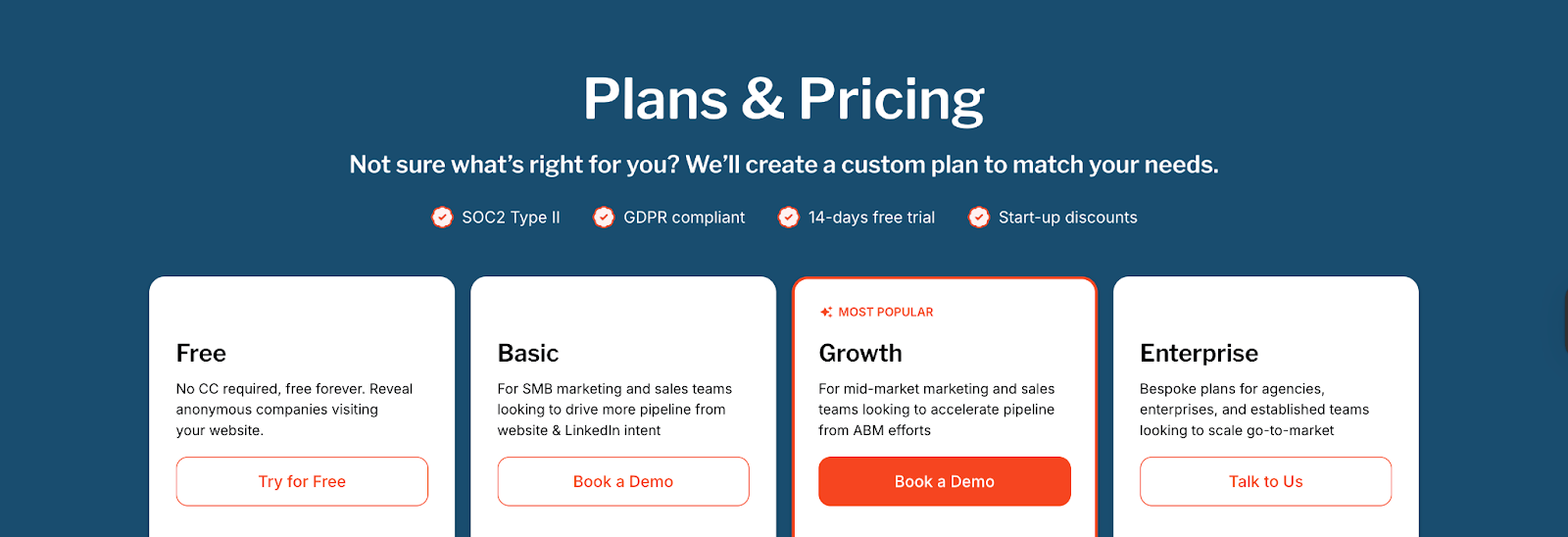
Every Factors plan is transparent about usage limits, integrations, and reporting capacity, which helps businesses estimate ROI against team size and pipeline goals.
Lead Forensics Pricing
Lead Forensics keeps its pricing simple with two plans:
- Plan 1: Essential (for SMBs)
Includes core capabilities like:- Seeing which businesses visit your website
- Obtaining business contact details for identified prospects
- Keyword-level traffic insights
- Access to Lead Manager portal
- Plan 2: Automate (for enterprises)
Builds on Essential by adding:- Advanced CRM integrations
- Fully customizable workflows
- ‘The Orchestrator’ technology to automate sequences
- ‘Fuzzy Matching’ algorithms for cleaner data
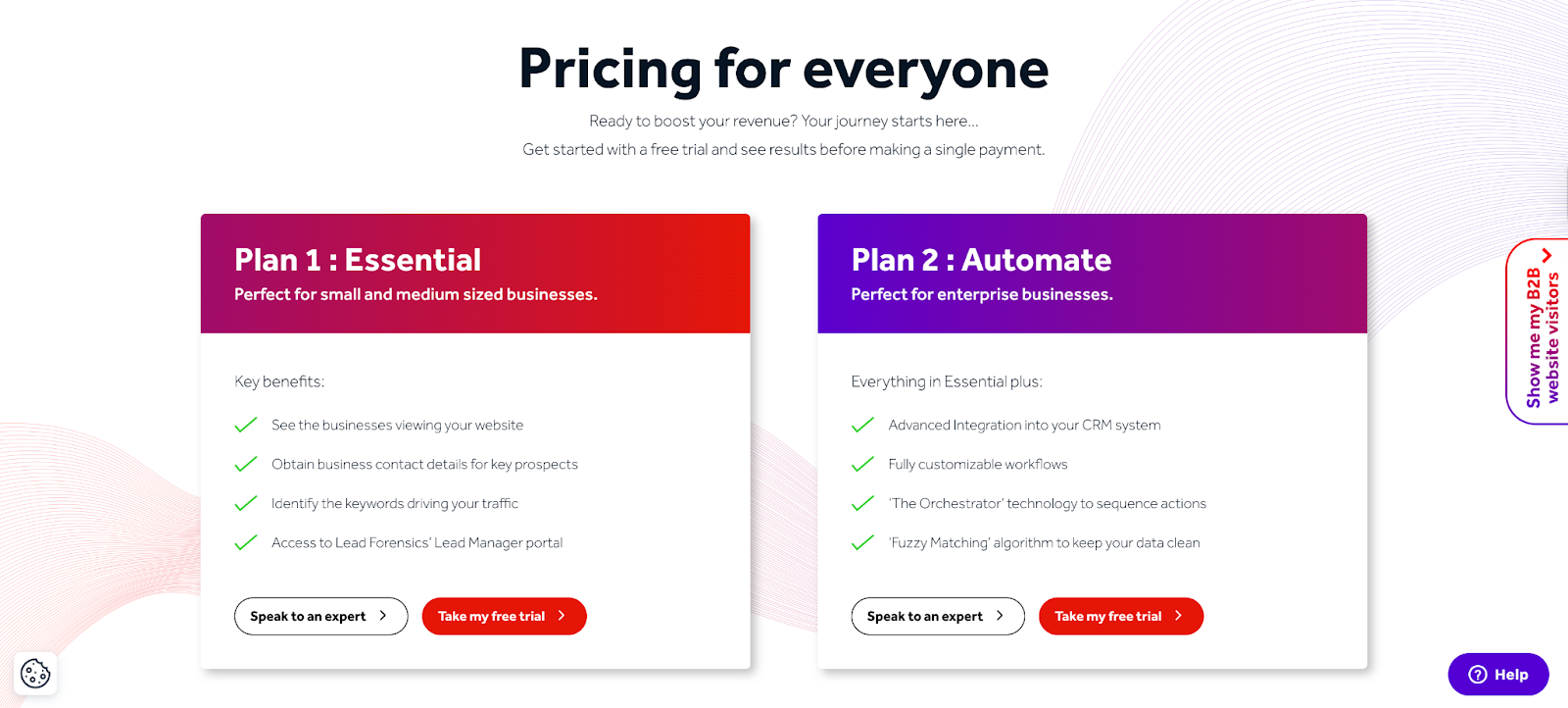
Lead Forensics does not publicly list its pricing in dollar terms, requiring prospects to ‘speak to an expert’ for a quote. The plans are structured less around usage (companies identified, seats, or reports) and more around functionality tiers.
Points to Note
- Lead Forensics positions itself as simplicity-first: two plans, a rich database, and enterprise-capable functionality, but doesn’t reveal pricing, which can challenge budgeting.
- Factors leans into transparency and clarity. The tiered structure helps teams match cost to growth precisely, starting from zero. It also layers in advanced features earlier, especially ABM and attribution, making it easier to scale thoughtfully.
Factors vs Lead Forensics: Compliance and Security
| Compliance Area | Factors | Lead Forensics |
|---|---|---|
| GDPR | ✅ | ✅ |
| CCPA | ✅ | ❌ |
| ISO 27001 | ✅ | ✅ |
| SOC 2 Type 2 | ✅ | ❌ |
| Privacy-First Enrichment | ✅ Non-invasive, secure | ❌ Not transparent |
Factors
- ISO 27001
- SOC 2 Type 2
- GDPR and CCPA compliance
- Privacy-first enrichment practices
- Signed DPAs and security documentation on request
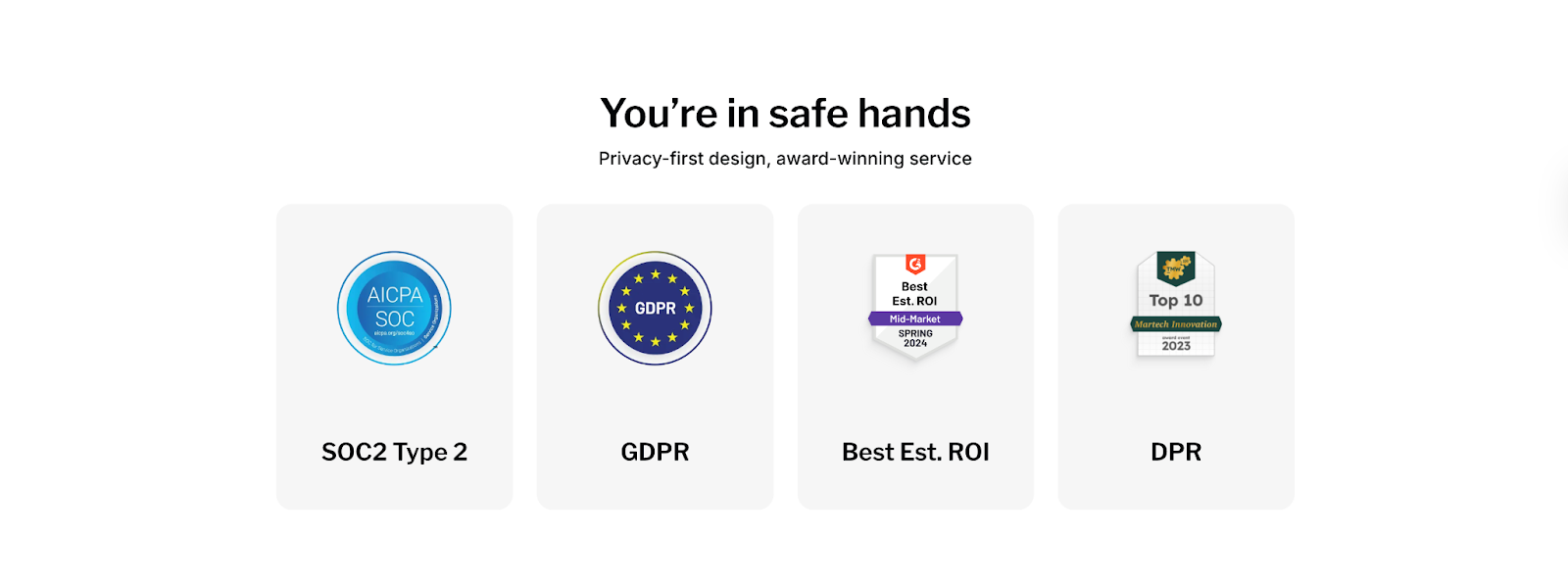
Lead Forensics
Lead Forensics is ISO 27001 and GDPR compliant, but doesn’t currently offer SOC 2 Type 2 or transparent details on data enrichment methods. That might not matter to some teams, but for regulated industries or larger deal cycles, it can be a red flag
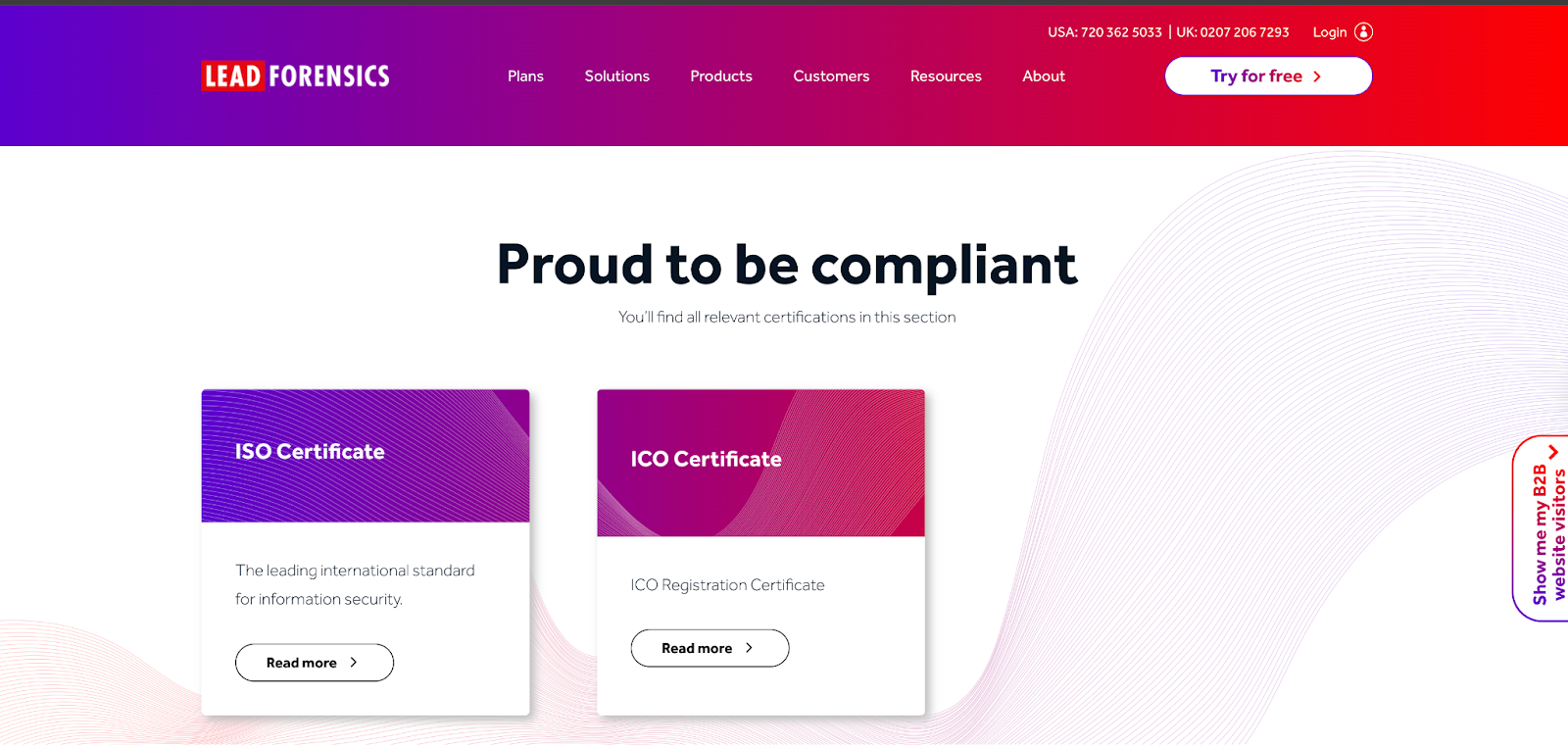
Factors vs Lead Forensics: Onboarding and Support
| Criteria | Factors | Lead Forensics |
|---|---|---|
| Onboarding | White-glove onboarding; structured by plan (1 session in Free/Basic, bi-weekly reviews in Growth, weekly reviews in Enterprise) | Standard onboarding; setup of tracking and dashboards |
| Customer Success Manager | Dedicated CSM for Growth and Enterprise; involved in GTM workflows and strategy alignment | Dedicated CSM for onboarding and adoption, primarily tool-focused |
| Review Cadence | Bi-weekly (Growth) and weekly (Enterprise) success calls; performance reviews included | Not publicly specified; support as needed |
| Support Channels | Email, helpdesk, on-call support (Enterprise), dedicated Slack/MS Teams channel | Live chat in portal, phone, email, helpdesk, knowledge base, documentation |
| Additional Services | Optional GTM Engineering Services: workflow design, integrations, RevOps consulting, system documentation | Support focused on technical implementation; no advanced GTM workflow services |
Adopting an account intelligence or ABM platform is not just a product decision, it’s a process commitment. The depth and quality of onboarding, along with the level of customer support, often determine how quickly teams realize value from their investment.
Factors
Factors delivers white-glove onboarding and consultative support that extends beyond tool training into building a scalable GTM motion. Depending on the plan, customers receive:
- A dedicated Slack channel for real-time collaboration with the Factors team
- Regular strategy reviews with a Customer Success Manager (bi-weekly for Growth plans, weekly for Enterprise)
- Custom GTM playbooks tailored to ICP fit, funnel stages, and sales processes
- Hands-on workflow design covering ad activation, enrichment flows, sales alerts, and journey orchestration
- Optional GTM Engineering Services, where Factors acts as an extension of your RevOps function, implementing workflows, integrations, and system documentation across your GTM stack
- Pre-built workflows for real-time Slack/MS Teams alerts, closed-lost re-engagement, decision-maker surfacing, SDR research summaries, and multi-threaded account signals

This structured approach ensures teams don’t just learn how to use the platform but also embed ABM and RevOps best practices directly into their operations.
Lead Forensics
Lead Forensics provides a more traditional onboarding model that helps teams get the platform up and running quickly. Their offering includes:
- A dedicated Customer Success Manager to guide customers through setup and adoption
- Assistance with JavaScript tracking setup and CRM/marketing integrations, including HubSpot, Salesforce, and Zapier
- Multiple support channels, including live chat within the portal, phone, email, and access to a knowledge base with documentation for self-service
While this model covers the essentials of implementation and integration, the onboarding is primarily focused on platform access and functionality rather than GTM strategy design or advanced workflow orchestration.
Factors vs Lead Forensics: Analytics and Attribution
Factors
Factors is designed as more than a visitor tracking platform, it’s an all-in-one demand generation platform.
Factors also provides account-level, multi-touch attribution, full-funnel analytics that connect engagement to outcomes.
Key capabilities include:
- Unified account timelines: Stitch together every touchpoint, from anonymous website visit to closed-won deal, into a single journey.
- Multi-channel performance breakdowns: Attribute pipeline influence across Google Ads, LinkedIn, G2, organic traffic, and other sources.
- Funnel progression analysis: Track movement from MQLs through SQLs to opportunities and revenue, with visibility into conversion rates at each stage.
- Segmentation: Analyze performance by geography, ICP, vertical, or persona to uncover what resonates with different segments.
- Path-to-conversion mapping: See the sequences that lead to deals (e.g., ad engagement → demo request → nurture email → opportunity).
- Drop-off analysis: Identify where high-fit accounts are stalling or disengaging, and trigger re-engagement workflows.
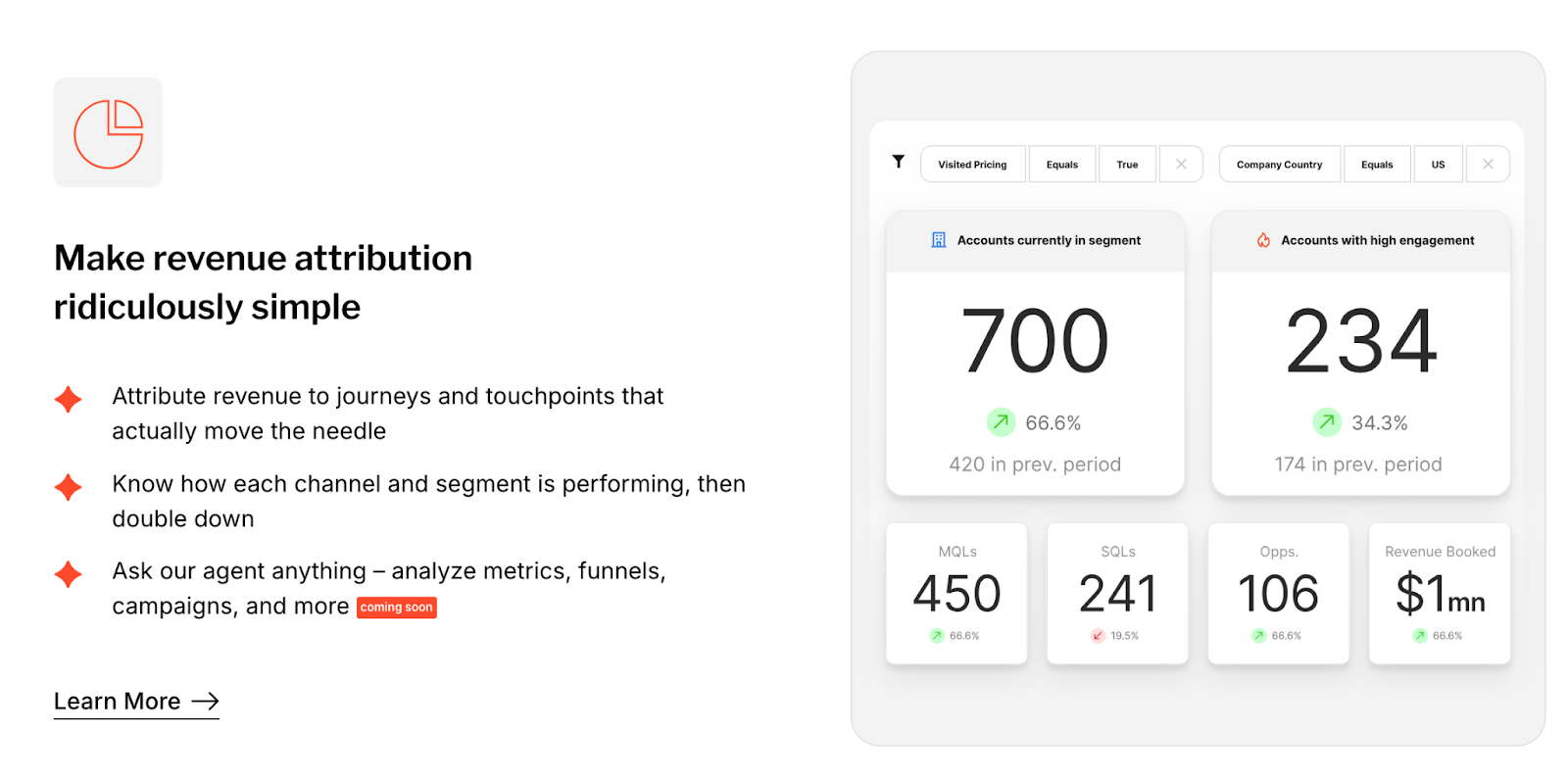
For revenue-driven teams, this results in multi-touch attribution, funnel visibility, and diagnostic insights that tie marketing and sales actions back to pipeline.
Lead Forensics
Lead Forensics focuses on website visitor identification and engagement visibility. Its analytics provide clarity into who is visiting and what content is being consumed. Available capabilities include:
- Identifying anonymous visitors through reverse IP lookup
- Tracking which pages were viewed and for how long
- Monitoring visitor activity trends through built-in dashboards
- Exporting visitor data to CRMs or BI tools for further reporting
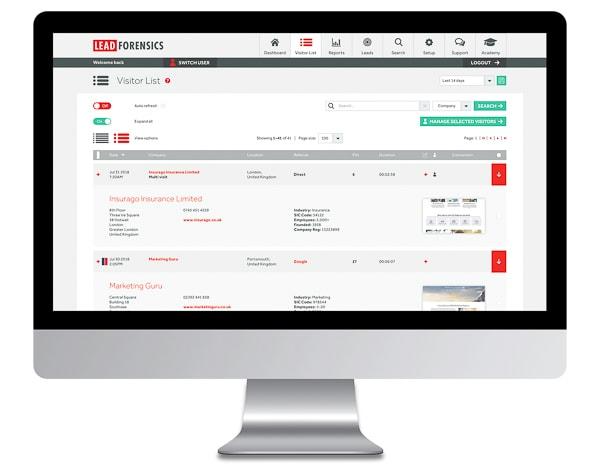
This makes it effective for understanding content engagement and top-of-funnel lead generation. However, Lead Forensics does not extend into funnel analytics or revenue attribution. It does not natively connect visits to pipeline creation, track multi-touch journeys, or diagnose conversion bottlenecks.
All in all, Lead Forensics provides visibility into visitor activity and content engagement, which suits teams focused on lead identification. However, Factors extends this visibility into attribution and revenue impact, giving teams the ability to measure and optimize across the full funnel.
Factors vs Lead Forensics: Ad Activation and Retargeting
| Criteria | Factors | Lead Forensics |
|---|---|---|
| LinkedIn Audience Sync | Native, real-time sync by stage and behavior | Not available (manual CSV export/Zapier only) |
| Google Ads Retargeting | Retarget accounts by paid search terms | Not available natively |
| Ad Frequency Control | Control impressions per account to reduce skew | Not available |
| Feedback Loop to Platforms | Conversion data fed back to optimize targeting | Not available |
| Stage-Based Segmentation | Sync audiences by funnel stage, product interest, or CRM logic | Not available |
Visitor intent data only creates value if it can be activated. This is where the two platforms take very different approaches.
Factors
Factors integrates intent and engagement signals directly into ad platforms, turning insights into targeted campaigns. With Factors, you can:
- Sync high-fit audiences to LinkedIn in real time, dynamically updating based on intent signals
- Retarget Google visitors who engaged with key search terms
- Control ad impression frequency by account to reduce waste and increase relevance
- Feed conversion and engagement data back into ad platforms to continuously refine targeting and improve ROAS

This approach transforms account intelligence into a working GTM engine, ensuring that ad spend is tightly aligned to buyer activity and funnel stage.
Lead Forensics
By contrast, does not offer native ad platform integrations. Teams can export visitor data via CSV and upload it manually to LinkedIn or Google Ads, or use third-party connectors like Zapier to set up basic automations. However, these methods do not provide real-time sync, buyer-stage segmentation, or campaign feedback loops.
Factors vs Lead Forensics: Which B2B website visitor identification platform should you choose?
| Best For | Factors | Lead Forensics |
|---|---|---|
| Primary Goal | End-to-end demand generation: identify, prioritize, activate, and attribute | Identify anonymous website visitors and generate contactable leads |
| Strengths | Multi-source intent signals, account scoring, ad activation, attribution | Simple dashboards, visitor visibility, CRM integrations, easy outbound starter |
| Ideal Team Profile | Revenue teams needing full-funnel GTM execution and ROI accountability | Early-stage teams testing outbound flows, focusing on top-of-funnel visibility |
| Activation | Native sync with LinkedIn & Google Ads in real time | Manual exports or Zapier for ads |
| Analytics | Full-funnel attribution, conversion paths, drop-off diagnostics | Visitor counts, page-level insights |
| Support Model | CSM + Slack/MS Teams, white-glove onboarding, optional GTM Engineering | Dedicated CSM, phone/email/chat, knowledge base |
Both platforms can identify anonymous visitors, the real difference is what happens next.
Factors
Factors extends visitor identification into a complete go-to-market execution. It enables teams to:
- Identify up to 75% of visitors using waterfall enrichment combined with third-party intent signals
- Score, enrich, and prioritize accounts in real time based on ICP fit and engagement
- Automatically activate high-fit audiences on LinkedIn and Google Ads, no manual list uploads
- Access full-funnel attribution dashboards, from MQLs to closed-won revenue
- Get real-time Slack/MS Teams alerts for SDRs, ensuring timely follow-up
- Leverage AI-powered GTM agents, custom playbooks, and optional workflow engineering services to execute at scale
Lead Forensics
Lead Forensics is well-suited for teams focused on early-stage outreach and visibility. It provides:
- Reverse IP-based visitor identification with matched company and contact data
- Firmographic insights and page-level visit tracking
- Integrations with CRMs and marketing tools for exporting visitor data
- Easy-to-use dashboards, ideal for teams piloting outbound workflows
- Support through a dedicated Customer Success Manager, live chat, email, phone, and documentation
Lead Forensics is a good choice for website visitor tracking and early prospecting. But if your team wants to connect visitor identification to ABM campaigns, full-funnel analytics, ad activation, and revenue attribution, Factors delivers a complete solution.
It’s not just a tool, it’s an end-to-end B2B demand generation platform that unifies data, workflows, and outcomes.
See why leading B2B teams think Factors is the best Lead Forensics alternative. Schedule your demo today.
.png)
Factors vs Happierleads: Which alternative is best for B2B teams?
This guide explores Factors as a Happierleads alternative for B2B teams evaluating visitor identification and signal-driven GTM platforms. It highlights what each product does well, where their limitations lie, and which option best matches your stage of growth.
You’ll find side-by-side detail on four areas buyers like you care about most:
- Functionality & Features: what you can actually do day to day
- Pricing: plan structure and what’s included at each tier
- Compliance & Security: certifications and data handling
- Onboarding & Support: how quickly you can get value and the help you’ll receive
The comparisons are based on product pages, plan screenshots, and other publicly available materials shared in this document. Capabilities and pricing can change; use this as a starting point for a vendor conversation and a proof-of-value plan.
If you need a quick takeaway: Happierleads is geared toward identifying visitors and launching outreach fast, while Factors aims to turn buying signals into coordinated campaigns and measurable pipeline.
Factors vs Happierleads: Functionality and Features
| Feature | Factors | Happierleads |
|---|---|---|
| Website visitor identification | Sequential enrichment via multiple data vendors (6sense, Clearbit, etc.) | Pixel-based tracking |
| Account match accuracy | Up to 75% with geo, firmographic, and role filters | No numerical accuracy percentage anywhere officially |
| Contact-level intel | AI agents identify and tier contacts based on buying relevance | Includes complete email outreach, CRM/ Zapier, real-time alerts, and engagement tools. |
| Intent signal sources | 1st-party (web, product, CRM), 2nd-party (ads, G2), 3rd-party (CSV) | Tracks individual visits, engagement for follow-up |
| Customer journey timelines | Available across website, CRM, ads, and product data | Not available |
| Account scoring & prioritization | Real-time based on engagement, ICP, and external signals | Pixel tracking plus lead scoring, and event tracking. |
| AI agents for outreach & insights | Included with ability to auto-research accounts and alert SDRs | Built-in email automation, segmentation, and real-time outreach exist, though not mentioned as "AI agents" |
| Multi-threading & buying group map | Auto-identification and grouping by role and influence | Not available |
| Ad platform integrations | LinkedIn & Google (native), with real-time audience sync | Not available |
| Sales enablement alerts | Slack/MS Teams alerts based on geo, activity, and funnel stage | Offers real-time notifications of visitors and outreach triggers |
Visitor identification platforms have become a staple in modern B2B marketing stacks. They promise the ability to see ‘who’s on your site,’ but the real question for growth-minded teams is: what happens next?
Some solutions stop at visibility, leaving it to your sales and marketing teams to figure out the rest. Others combine identification with intelligence, automation, and activation, helping you not only recognize potential buyers but also engage them at the right moment, through the right channels.
Factors
Factors falls firmly into the second category. It’s a B2B demand generation and GTM orchestration platform designed to turn intent signals into revenue, all within a single system. Using a combination of AI Agents and integrated workflows, Factors enables teams to:
- Account & Contact Scoring
Prioritize the highest-potential accounts with scores based on ICP fit, funnel stage, and engagement intensity, ensuring sales efforts focus on the right targets. - Customer Journey Timelines
View every interaction, across website, ads, product usage, and CRM, in chronological order to understand true buyer behavior. - AI-Driven Contact Insights
Leverage AI agents to surface relevant contacts within each account, provide tailored outreach insights, and track deal momentum. - Dynamic Ad Activation
Sync target account audiences to LinkedIn and Google Ads in real time for efficient targeting, in-funnel retargeting, and precise ABM execution. - GTM Engineering
Pair automation with strategic services to operationalize your intent data, from real-time SDR alerts and buying group mapping to closed-lost reactivation and post-meeting engagement tracking. - Milestones & Funnel Analytics
Identify which actions and content drive progression between funnel stages, uncover drop-off points, and validate GTM experiments with data. - Account 360 View
Unify every touchpoint, from marketing engagement to sales activity, in one sortable account view, enabling GTM alignment and precision targeting. - AI Alerts
Receive contextual, real-time alerts for moments that matter, such as form-fill drop-offs, security document views, or demo revisit activity. - Advanced Google Ads Capabilities
From Google CAPI integration for richer conversion signals to audience syncing that ensures only ICP-fit accounts see your ads, Factors makes your ad spend work harder. - Real-time Slack/MS Teams Notifications
Instantly notify sales teams when accounts perform high-intent actions. - Multi-threading & Buying Group Identification
Identify and engage multiple decision-makers to avoid deal risk and shorten sales cycles.
This level of orchestration makes Factors particularly suited for teams ready to scale ABM and outbound motions without drowning in manual work.

Happierleads
Happierleads, on the other hand, offers a more streamlined, visitor-focused workflow. It’s built to help teams quickly identify who’s visiting their website and initiate outreach. The platform’s process is straightforward:
- Install the tracking pixel
Add a pixel to your site in a few clicks. - See your visitors
Identify the companies visiting and learn more about them. - Set up your campaign
Use Happierleads’ native tools to create and automate email outreach. - Meet with your leads
Book demos or connect directly with identified prospects.
This approach gives users an immediate way to connect website visits to outreach activities. For companies looking for a simple, direct method to capture and contact leads, this can be effective. However, it does not extend into more advanced areas such as multi-channel ad audience activation, complete customer journey mapping, or deep GTM automation.
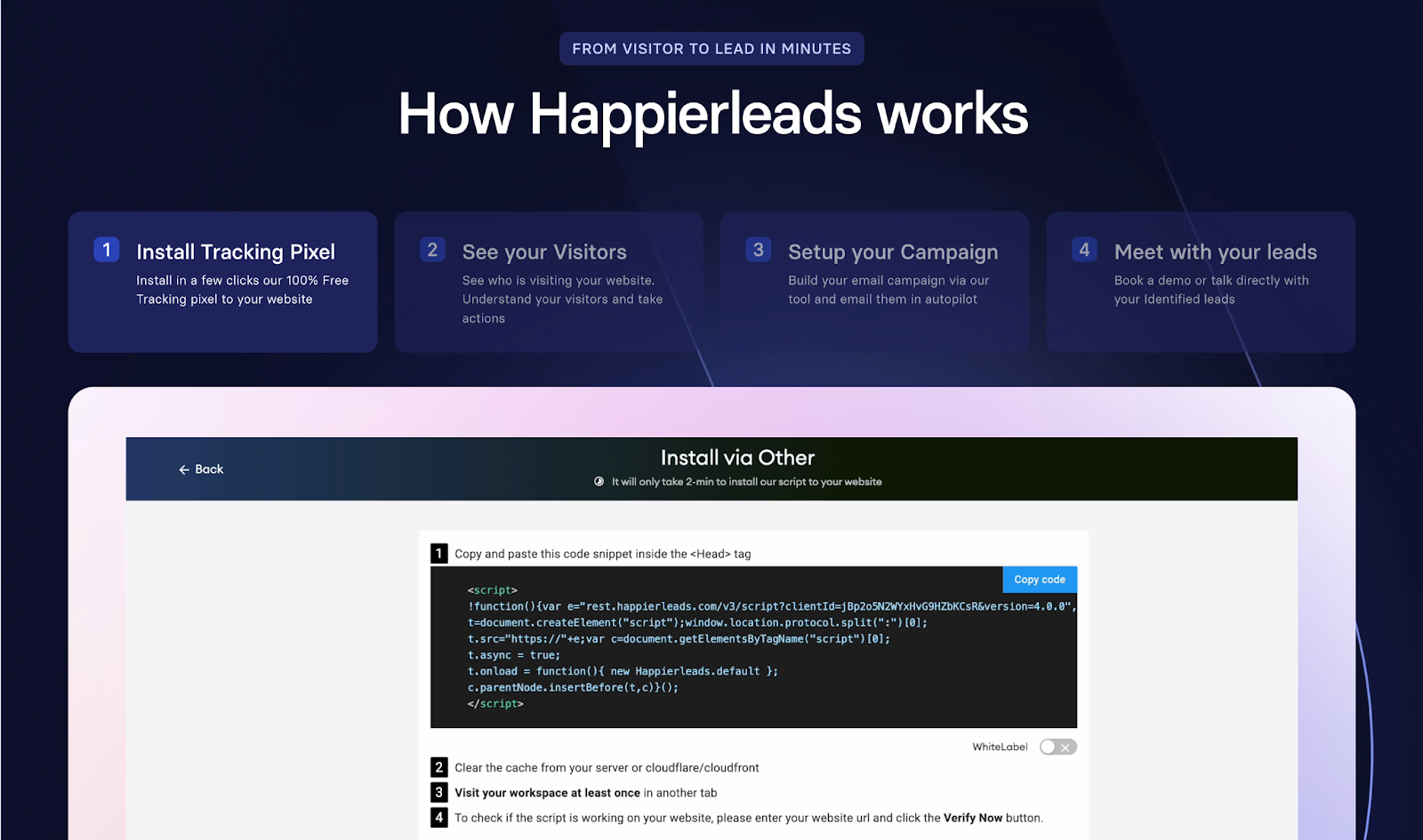
Factors vs Happierleads: Pricing
| Aspect | Factors | Happierleads |
|---|---|---|
| Entry-level option | Free tier (200 companies/month, 3 seats) | Free tier (150 credits/month, 1 website, unlimited users) |
| SMB Plan | Basic ($ — 3,000 companies, LinkedIn intent, CRM light integration) | Business ($99/mo — 300 credits, CRM + email campaigns) |
| Mid-market Plan | Growth (8,000 companies, ABM analytics, G2 intent, AdPilot, CSM) | Agencies ($949/mo — unlimited websites, API, whitelabel) |
| Enterprise Plan | Enterprise (custom usage, predictive scoring, Google AdPilot, 3rd-party intent, custom integrations) | Custom pricing — custom integrations, training, priority support |
| CRM integrations | HubSpot, Salesforce, Marketo, Drift (full integration at higher tiers) | Native CRM integrations at Business tier and above |
| Ad platform integrations | LinkedIn, Google, Bing, Facebook (native) | ❌ Not available |
| G2 Buyer Intent | ✅ (native integration) | ❌ Not available |
| White-glove onboarding | ✅ (Enterprise) | ✅ (Custom plan only) |
When evaluating pricing, it’s important to look beyond the monthly or annual subscription cost and consider the value generated per dollar spent. A tool that consolidates multiple workflows, reduces manual effort, and drives measurable pipeline impact can often deliver a stronger return than a lower-cost option with limited scope.
Factors Pricing Plans
1. Free Plan – For early-stage teams
- 200 companies identified/month
- Up to 3 seats
- Company identification
- Customer journey timelines
- Starter GTM dashboards
- Up to 5 segments
- Up to 20 custom reports
- 1 real-time Slack/MS Teams alert
- 1-month data retention
- Integrations: Website, Slack, MS Teams
2. Basic Plan – For SMB teams
- 3,000 companies identified/month
- Up to 5 seats
- Everything in Free, plus:
- Up to 10 segments
- LinkedIn intent signals
- CSV imports & exports
- Advanced dashboards & website analytics
- Custom metrics & KPIs
- Global exclusion rules
- GTM workflows
- Email & helpdesk support
- Up to 50 custom reports
- Up to 2 active Slack/MS Teams alerts
- Integrations: Google, LinkedIn, Facebook, Bing, HubSpot, Salesforce (Accounts/Opportunities), Zapier/Make
3. Growth Plan (Most Popular) – For mid-market teams
- 8,000 companies identified/month
- Up to 10 seats
- Everything in Basic, plus:
- ABM analytics
- Account scoring
- Up to 20 segments
- LinkedIn AdPilot
- G2 intent signals + attribution
- Segment insights & interest groups
- Workflow automation & data sync
- Dedicated CSM
- Up to 100 custom reports
- Up to 10 Slack/MS Teams alerts
- Integrations: HubSpot (full), Salesforce (full), Marketo, G2, Drift
4. Enterprise Plan – For large enterprises
- Custom companies identified/month
- Up to 25 seats
- Everything in Growth, plus:
- Up to 50 segments
- Predictive account scoring
- Google AdPilot (coming soon)
- Journey milestones
- 3rd-party intent upload
- White-glove onboarding support
- Up to 300 custom reports
- Up to 15 Slack/MS Teams alerts
- Integrations: Segment, Rudderstack, custom integrations
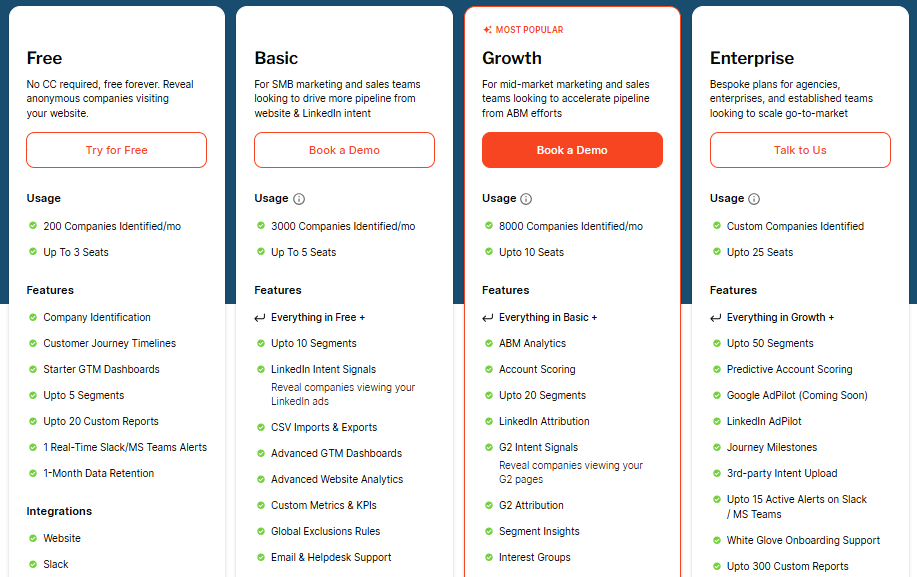
Visit Factors' pricing page to know more about different plans and their specifications.
Happierleads Pricing Plans
1. Free Plan – Entry-level
- $0/month (no credit card required)
- 150 credits/month
- 1 website
- Unlimited users
- Personal identification (US)
- Company identification (EU)
2. Business Plan – For SMBs
- $99/month (discounted from $199)
- Everything in Free, plus:
- 300 credits
- Visitor qualification
- CRM integrations
- Email campaign engagement
- AI summary
- Email verifications
- Integrations & exports
3. Agencies Plan – For marketing agencies
- $949/month (discounted from $999)
- Everything in Business, plus:
- 10,000 credits
- Unlimited websites
- Full white label
- Full API access
- Resell without restrictions
- Custom branding
- Personalized onboarding
4. Custom Plan – For advanced needs
- Pricing on request
- Everything in Agencies, plus:
- Unlimited websites
- Training options
- Build custom integrations
- Priority support

Factors vs Happierleads: Compliance and Security
| Compliance Area | Factors | Happierleads |
|---|---|---|
| GDPR Compliant | ✅ | ✅ |
| CCPA Compliant | ✅ | ✅ |
| ISO 27001 Certification | ✅ | ❌ |
| SOC 2 Type I & II | ✅ | ❌ |
| Signed Data Processing Agreement | ✅ | ❌ |
| Privacy-first enrichment | ✅ Firmographic & behavioral signals, no invasive tracking | ❌ Primarily pixel/cookie-based |
For B2B SaaS companies, especially those serving mid-market and enterprise clients, data privacy and platform security are not optional. They influence procurement timelines, customer trust, and the overall viability of a solution in regulated industries.
Factors
- GDPR Compliant
- ISO 27001 Certified
- SOC 2 Type I and Type II Certified
The platform also offers:
- Signed Data Processing Agreements (DPAs)
- Transparent terms and security documentation
- Privacy-first enrichment workflows that avoid invasive user fingerprinting or sketchy data sources
This becomes especially critical when activating campaigns across LinkedIn or syncing enriched contacts into CRMs. You need a partner that respects your customers’ data and meets the standards of your customers.

Happierleads
Happierleads offers basic compliance: they are GDPR and CCPA aligned. But there’s no public mention of SOC 2 or ISO certification, nor clarity on data sources, fingerprinting methods, or platform architecture. For many teams, this introduces unnecessary risk.

Factors vs Happierleads: Onboarding and Support
| Support Area | Factors (for reference) | Happierleads |
|---|---|---|
| Free onboarding | Limited (Free tier support) | ❌ |
| Dedicated CSM | ✅ From Growth tier onwards | ✅ From Business tier onwards |
| Personalized onboarding | ✅ Enterprise | ✅ From Agencies plan |
| Training options | ✅ Enterprise + GTM Services | ✅ Custom plan |
| Custom integrations support | ✅ Enterprise + GTM Services | ✅ Custom plan |
| Priority support | ✅ Enterprise | ✅ Custom plan |
A platform’s value isn’t just in its feature set, it also depends on how quickly and effectively your team can put it to use. Both Factors and Happierleads include onboarding support, but they differ in scope, depth, and the type of assistance provided after initial setup.
Factors
Factors focuses on building internal capability and aligning processes across marketing, sales, and operations. Support depth scales with pricing tiers:
- Free & Basic plans:
- Email & helpdesk support
- Starter dashboards and analytics setup
- Slack/MS Teams alerts (1 in Free, up to 2 in Basic)
- Growth plan:
- Everything in Basic, plus:
- Dedicated Customer Success Manager (CSM)
- Up to 10 active Slack/MS Teams alerts
- Workflow automations and data sync guidance
- Enterprise plan:
- Everything in Growth, plus:
- White-glove onboarding support
- Expanded Slack/MS Teams alerts (up to 15)
- Up to 300 custom reports
- Access to predictive scoring and journey milestones ensures deeper consultative setup
For companies seeking hands-on partnership, Factors also offers GTM Engineering Services (outside the standard tiers). This includes ICP definition, multi-channel activation setup, workflow automation, and ongoing optimization, effectively serving as an extension of your RevOps team.
This tiered approach ensures smaller teams can start quickly, while mid-market and enterprise organizations receive the consultative support required to operationalize GTM at scale.
Happierleads
Happierleads offers a more streamlined onboarding process that gets teams operational quickly for its core use cases. This typically includes:
- Dedicated CSM during setup to guide initial configuration
- Pixel installation support to enable visitor tracking
- Native CRM integration setup to sync visitor data into your existing sales tools
- Walkthrough of traffic reports to help teams interpret early visitor data
While this ensures fast activation for visitor identification and email outreach, Happierleads does not include a consultative RevOps layer, sales enablement support, or downstream integrations with ad platforms.Happierleads also offers onboarding in its higher tiers (Agencies and Custom). The support model is primarily geared toward platform configuration, such as setting up CRM integrations, customizing branding, or enabling whitelabel features. For fast-scaling teams looking to align multi-channel GTM activities, this difference can be meaningful.
Factors vs Happierleads: Analytics & Attribution
| Capability | Factors | Happierleads |
|---|---|---|
| Campaign-level attribution | ✅ Multi-touch journey and ROI visibility | ❌ |
| Funnel stage analytics | ✅ Tracks MQL → SQL → Opp → Deal | ❌ |
| Channel comparison & impact | ✅ Full-funnel insights across paid, organic, G2, etc. | ❌ |
| Account-level reporting | ✅ Engagement, revenue, pipeline by segment | ❌ |
| Drop-off & bottleneck detection | ✅ Identifies points of churn, inactivity, and loss | ❌ |
| Conversion path visualization | ✅ Know which touchpoints contributed to the deal | ❌ |
| Custom dashboarding | ✅ Segments by geo, funnel, campaign, ICP | ❌ |
Understanding who is visiting your website is valuable, but for many teams, the real impact comes from understanding why they’re there, how they arrived, and what actions ultimately drive them to convert. This is where analytics and attribution capabilities play a central role.
Factors
Factors combines engagement tracking with revenue attribution, providing a connected view of every stage in the buyer’s journey. Every interaction, across web, ads, CRM, and product, is stitched into a single, unified timeline. With this, teams can:
- Attribute pipeline and revenue to specific channels such as LinkedIn, Google, organic search, referrals, and G2.
- Analyze account performance by geography, segment, deal stage, or product line.
- Measure campaign influence over time using multi-touch attribution.
- Visualize conversion paths to identify which sequences of actions lead to deals.
- Identify bottlenecks by spotting drop-offs or friction points in the funnel.
- Compare performance across dimensions like:
- Accounts exposed to LinkedIn ads vs those that weren’t
- Accounts targeted via Google Ads vs cold traffic
- Organic visitors from different content sources
- Accounts engaging on G2 vs standard inbound leads
This level of insight enables marketing and revenue teams to optimize budgets, refine targeting, and scale high-performing plays with confidence.
Happierleads
Happierleads focuses primarily on visitor identification and engagement through outreach. Its analytics capabilities are designed to give GTM teams fast access to who is on their site and what they’re doing. Typical features include:
- Reporting on identified visitors with firmographic and technographic details
- Basic activity tracking (visits, page views, repeat sessions) within the platform
- Viewing visitor data by company, industry, and visit frequency
- Integrations with CRM and automation tools (such as HubSpot or via Zapier) to push leads into outbound or nurture sequences
For teams just starting with account-based marketing or those prioritizing quick visitor visibility, this lightweight reporting can be valuable. While it does not extend to advanced areas like multi-channel attribution, journey mapping, or deep revenue connection, it serves as a straightforward way to convert anonymous traffic into actionable contacts and route them into sales and marketing workflows.
Factors vs Happierleads: Ad Activation & Retargeting
| Capability | Factors | Happierleads |
|---|---|---|
| LinkedIn Ads integration | ✅ Official Partner, native audience sync | ❌ |
| Google Ads integration | ✅ Retargeting + Google CAPI feedback | ❌ |
| Dynamic audience updates | ✅ Based on real-time intent & buyer stage | ❌ |
| Ad impression control | ✅ Budget pacing per account | ❌ |
| Retargeting based on G2 & website data | ✅ Cross-platform journey-based targeting | ❌ |
| Multi-channel activation workflows | ✅ Ads, outreach, alerts — all triggered from one engine | ❌ |
In modern demand generation, identifying high-fit accounts is only the first step. The next, and often most critical, step is activation: reaching those accounts with the right message, at the right time, through the right channels. This is where the differences between Factors and Happierleads become most apparent.
Factors
Factors pairs account intelligence with native advertising integrations, turning intent signals into coordinated, multi-channel campaigns. As an official partner for both LinkedIn and G2, the platform offers capabilities such as:
- Dynamic LinkedIn audience creation and updates based on funnel stage, geography, ICP match, or ad engagement.
- Cross-channel retargeting for accounts that interact with Google Ads, landing pages, or even G2 competitor profiles.
- Conversion feedback loops, when SDRs mark a lead as high quality, Factors automatically signals LinkedIn to serve more ads to similar profiles.
- Impression and budget control to prioritize high-intent accounts and reduce spend on low-value traffic.
By continuously refreshing and optimizing audiences, Factors ensures that ad dollars are spent on accounts already demonstrating buying interest, rather than on static ABM lists that can quickly become outdated.
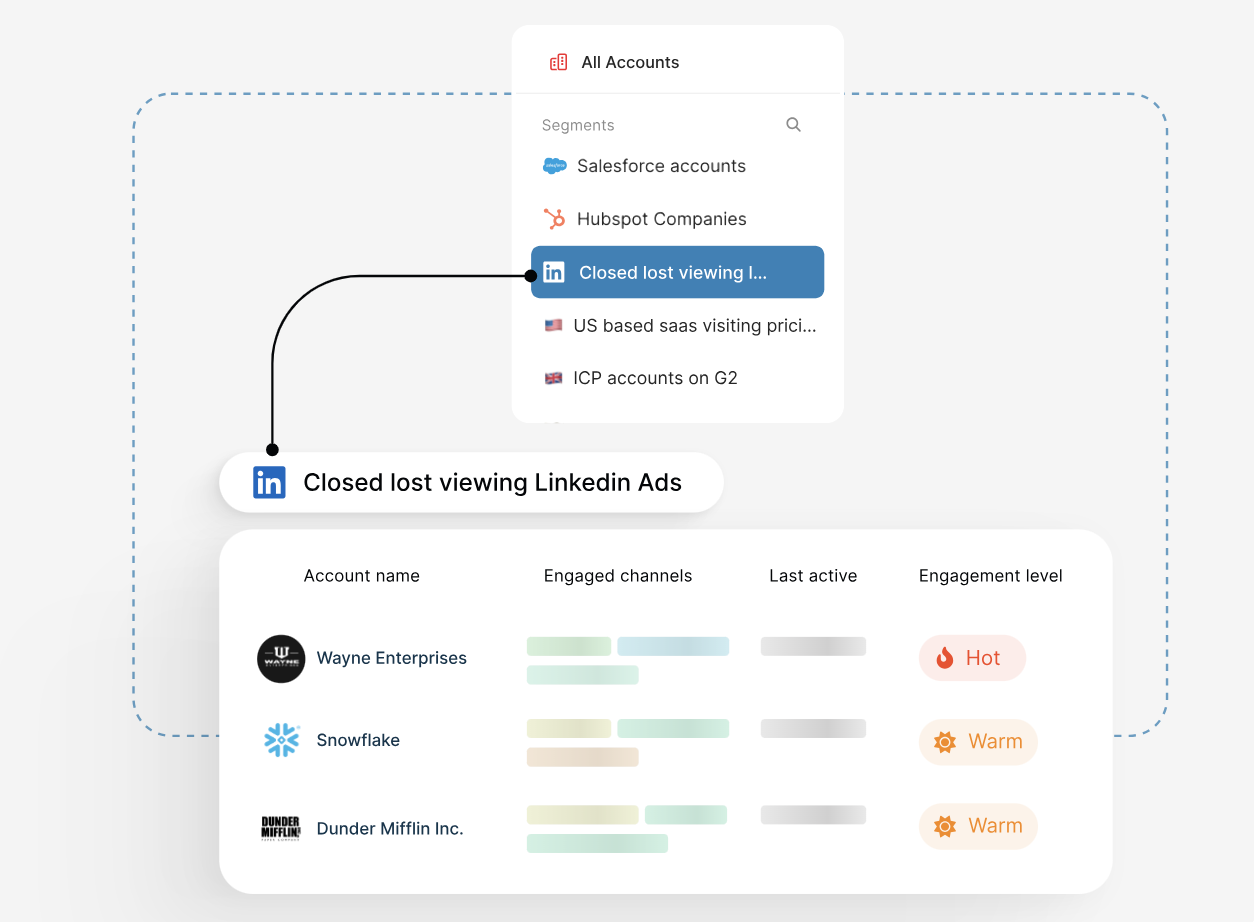
Happierleads
Happierleads focuses primarily on visitor identification and outreach. It does not currently offer ad platform integrations, meaning:
- No native audience syncing to LinkedIn or Google Ads.
- No dynamic audience updates based on buyer behavior.
- No impression control or automated budget allocation.
- No feedback loops from sales activity into ad targeting.
For teams investing heavily in paid media, the absence of these capabilities can lead to fragmented GTM execution, higher ad waste, and more manual coordination between marketing and sales.
Factors vs Happierleads: Which visitor tracking and GTM platform should you choose?
| If You Want To... | Choose |
|---|---|
| Identify website visitors with basic enrichment | Happierleads |
| Activate and convert high-intent accounts | Factors |
| Orchestrate ads, sales, and signals in one place | Factors |
| Score accounts and surface the right contacts | Factors |
| See which campaigns and touchpoints drive revenue | Factors |
| Run ABM ads based on real-time buyer behavior | Factors |
| Scale without hiring an in-house GTM ops team | Factors + GTM Services |
If you’re comparing Factors and Happierleads, you’re likely trying to solve one of two problems:
- You want to know who’s visiting your site.
- You want to turn that insight into revenue.
Happierleads can help with the first. It gives you firmographic data tied to site visits, and in some cases, associated contacts. But it doesn’t go further, there’s no scoring, no CRM logic, and no buying signals from ads, G2, or product usage. Automation is limited to email outreach and basic segmentation, without broader GTM or multi-channel activation capabilities.
Happierleads may be the right choice if you’re only looking to identify who has visited.
But if your real problem is:
- Missed buying windows
- Wasted ad spend
- Low outbound conversions
- No visibility into pipeline sources
- A disconnected GTM motion
…then Factors is a better Happierleads alternative for you.
It identifies high-intent accounts. It scores and prioritizes them. It syncs them to your ad platforms. It alerts your reps. It helps you multi-thread deals. It even enables you to prove what’s working across the funnel. Most importantly, it scales your GTM system, not just your lead list.
Whether you’re a marketing leader trying to double pipeline without doubling headcount, or a RevOps lead trying to consolidate tools and workflows, Factors turns noisy signals into pipeline-driving action.
Looking to know more about what Factors has in store for you? Book a demo, and let us walk you through it.

A Partnership for High-Performance Demand Gen Teams: Factors.AI X TripleDart Partnership
Modern B2B marketing doesn’t live in silos. The buyers you’re targeting don’t move in linear funnels, and your GTM team shouldn’t be working with disconnected tools and disjointed strategies.
That’s where this partnership comes in.
TripleDart, a performance-driven B2B growth team, and Factors.ai, an all-in-one B2B demand generation platform, have joined forces to bring marketing and revenue teams a smarter way to run campaigns, reach the right accounts, and measure what actually drives pipeline.
This partnership combines TripleDart’s campaign execution expertise with Factors’ AdPilot, Google ABM, and AI-powered insights to help teams:
- Identify high-intent accounts in real time
- Run ABM campaigns across LinkedIn and Google Ads
- Automate outreach based on buying behavior
- Attribute pipeline to real revenue signals, not just clicks
Better Together: Here’s what this partnership unlocks
The TripleDart × Factors.ai partnership is more than a tech + agency arrangement, it’s a tightly aligned collaboration where both teams work as an extension of your GTM motion.
By combining capabilities, the partnership enables:
- Smarter Execution
TripleDart uses real-time buyer signals from Factors.ai to plan, build, and run ABM campaigns with greater precision. - Always-On Campaign Orchestration
With Factors' AdPilot and CRM integrations, accounts move seamlessly between awareness, consideration, and decision-stage campaigns, across both LinkedIn and Google Ads. - Performance Attribution Without the Gaps
Factors’ view-through attribution and LinkedIn CAPI integration ensures even non-click interactions are measured, so you never lose visibility on what’s working. - One Team. One Platform. One Outcome.
From audience targeting to campaign setup to pipeline attribution, both teams are working together to help you generate more qualified pipeline, faster.
Exclusive access to AdPilot: Run better ads for LinkedIn
TripleDart clients now get access to Factors’ Growth Plan and AdPilot, a powerful suite of features designed to improve targeting, efficiency, and ROI on paid campaigns.
Here’s how AdPilot helps orchestrate high-performing B2B campaigns:
1. Audience Builder
Use Audience Builder to target the accounts that matter most:
- Discover and qualify anonymous accounts interacting with your brand
- Segment high-intent accounts based on engagement across channels
- Seamlessly sync target accounts with your LinkedIn and Google Ads audiences
“Factors’ Audience Sync allowed us to tailor LinkedIn Ads to each stage of the customer journey. Awareness-stage users received educational content, while engaged users got personalized, actionable insights, ensuring precise targeting and effective engagement.”
- Shane Poyar, Growth and Mark Ops Manager at Descope
2. Smart Reach
Prevent uneven ad distribution with greater control over your budget:
- Maximize reach per dollar by managing impressions and clicks per account
- Ensure balanced exposure across target accounts
- Reduce waste from over-served audiences
3. Campaign Automation
Let buying signals drive execution:
- Use intent signals from sources like G2, your CRM, and website to trigger campaigns
- Reallocate impressions dynamically to priority accounts
- Accelerate deal closures by expanding reach when engagement is high
4. True ROI with View-Through Attribution + LinkedIn CAPI
Only 0.5% of your audience will click or fill out a form. But that doesn’t mean the other 99.5% didn’t see your ad.
- Measure LinkedIn’s influence through view-through attribution
- Feed complete conversion data into LinkedIn via Conversion API
- Bypass third-party cookies and track performance with first-party accuracy
AdPilot in Action
Case Study: Descope
Descope is a no-code, drag-and-drop platform for customer authentication and identity management. It enables enterprises and SMBs to customize user journeys with a product-led and sales-assist GTM approach.
The Challenge:
Their key challenge was long sales cycles with limited visibility into buyer journeys. They struggled to track user activity across platforms, identify key touchpoints, and focus efforts on what worked.
- Lack of visibility:
Descope wanted an understanding of users visiting their website, docs, and engaging off-platform on G2 or LinkedIn. - Manual ad targeting:
Reliance on manual list uploads led to missed engagement opportunities. In addition to this, their targeting also suffered due to a lack of real-time actions. - Wasted ad spend:
92% of accounts saw fewer than 100 ad impressions per month, while a few large accounts consumed most of the budget. - Fragmented reporting:
Descope’s team relied on spreadsheets and agencies for reporting, which slowed processes and limited insights.
The Solution:
Descope integrated Factors into their product-led and sales-assist strategy, driving key improvements:
- Full buyer journey visibility:
Sales teams now track account behavior and receive alerts when prospects show high intent. - Smarter ad targeting:
Factors’ Audience Sync tailored LinkedIn Ads to each customer journey stage, delivering relevant content and driving engagement. - Optimized ad spend:
Smart Reach helped distribute ~140k (25%) ad impressions across more accounts. - Clear channel performance insights:
Descope discovered LinkedIn Ads' impact beyond clicks, unlocking new opportunities. - First-party data adoption:
With the LinkedIn Conversions API (CAPI), Descope moved away from 3rd-party cookies to engage genuinely interested users.
➡️ Learn how you can boost your LinkedIn Ads ROI. Get in touch with us and Book a Demo!
We’ve got Google ABM, too
In addition to LinkedIn, Factors also enables ABM precision across Google Ads:
- Run targeted Google Display Ads for mid- and bottom-funnel engagement
- Sync high-intent accounts from your CRM, website, and G2 directly into Google
- Retarget accounts with messaging tailored to their buying stage
TripleDart uses this to orchestrate cohesive, cross-channel ABM campaigns that drive higher engagement and conversions.
Final Word: We’ve built this partnership for pipeline growth
TripleDart X Factors.ai is an integrated partnership that helps GTM teams:
- Eliminate guesswork
- Align paid campaigns with actual buyer behavior
- Optimize every stage of the journey, from discovery to closed-won
- Scale with a unified strategy and platform
If you're ready to build a high-performing demand generation engine that runs smarter, not harder, this partnership gives you everything you need to succeed.
Let’s run campaigns that convert, and build a GTM that performs.

Sales Toolkit: 29 Sales Tactics To Close More Deals In 2025
We all agree with the American author, Jeffrey Gitomer when says, “Quality performance starts with a great attitude”. But is that enough when it comes to sales? Unfortunately, not! But guess what, we get it — the sales journey can often feel like a rollercoaster ride, with peaks of triumphs and some valleys of challenges. But we’ve got you this toolkit with 30 sales tactics that will equip you to build better relationships with potential clients and arm you to turn challenging sales pitches into stepping stones for your success.
So, without much ado, let’s get started. Here are 30 sales tactics to drive more deals in 2025:
1. Benefits-Oriented Sales Pitches
Focus on emphasizing the benefits or value your product or service brings to the table rather than solely highlighting its features during sales pitches. By highlighting how your solution addresses specific pain points and improves outcomes, you can resonate more deeply with customer’s use-cases and pain-points.
Why will this technique work?
Prospects are ultimately interested in how a product or service can solve their problems and improve their situation. By prioritizing benefits over features, salespeople can effectively communicate the value proposition and relevance of their offering to the prospect's needs.
Rather than inundating prospects with technical specifications, paint a vivid picture of how your solution streamlines processes and boosts efficiency. For instance, illustrate how your software eliminates repetitive tasks, saving time and resources, thus making the work lives of your clients easier and more productive.

2. Offer Freemiums or Complimentary Trials and Demos
Provide prospects with the opportunity to experience your product through free trials or demos.
Why will this technique work?
Providing freemium or trial versions allows prospects to experience your product firsthand. By allowing hands-on exploration, salespersons can showcase the product's value and functionality, making it more enticing for prospects to convert.
A software company could offer a 14-day free trial, allowing potential clients to explore features before committing. Offer free trials or demos to give potential clients a hands-on experience with your product. For Example:, a software company could provide a 14-day free trial, allowing prospects to explore features and experience the value firsthand before committing.

3. Leveraging Email Automation and CRM Tools for Efficiency
Leverage email automation tools and Customer Relationship Management (CRM) software to streamline prospecting and lead nurturing processes. By automating repetitive tasks and centralizing customer data, sales teams can work more efficiently and effectively to manage their interactions with prospects.
Why will this technique work?
Automation reduces manual workload, allowing sales teams to focus more on building relationships and closing deals. Integration with CRM systems ensures that all interactions with prospects are tracked and managed systematically, leading to improved organization and follow-up
Factors.ai is an account intelligence solution that identifies and activates high-intent accounts engaging with your brand with workflow automations across LinkedIn, CRM, Slack/Teams, and your favorite mail sequencing tools. Learn more over a quick demo
4. Creating Urgency with Limited-time Offers
Employ limited-time offers to create a sense of urgency and prompt prospects to make a decision sooner rather than later. Whether it's a discount, bonus feature, or extended trial period, limited-time offers can push prospects towards a purchasing decision.
Why will this technique work?
Limited-time offers trigger the fear of missing out (FOMO) in prospects, compelling them to act quickly to take advantage of the offer before it expires. By introducing urgency, salespeople can expedite the decision-making process and increase conversion rates.
A limited time seasonal offer, for example, encourages customers to follow through with the purchase decisions, even in periods of relatively low engagement such as the holidays.

5. Establishing Authority through Thought Leadership
Position yourself or your company as an authority in the industry by sharing valuable insights, expertise, and knowledge through thought leadership content. This could include blog posts, whitepapers, webinars, or speaking engagements at industry events.
Why will this technique work?
Prospects are more likely to trust and engage with salespeople who demonstrate a deep understanding of their industry and offer valuable insights. By establishing authority through thought leadership, salespeople can build credibility and trust, making it easier to convert prospects into customers. Publish a series of blog posts or articles addressing common challenges or trends in your industry, providing actionable advice and solutions. Share these resources with prospects to showcase your expertise and differentiate yourself from
6. Developing Interactive Content for Engagement and Data Collection
Create interactive content, such as quizzes, assessments, or webinars, to engage prospects and gather valuable data. Interactive content not only captures attention but also provides insights into prospects' preferences and behavior.
Why will this technique work?
Interactive content is more engaging and memorable than traditional forms of content, making it an effective tool for capturing and retaining prospects' attention. Additionally, the data collected from interactive content can be used to personalize future interactions and tailor your offerings to meet prospects' needs.
Develop an interactive quiz related to your industry or target audience's interests. Not only does this capture leads' attention, but it also provides valuable data on their preferences and pain points. This doesn’t always have to be boring sales enablement. For example, here’s a fun interactive spin off of Wordle by Descope, an authentication platform:

7. Utilizing Referral Programs
Implement referral programs to leverage the trust existing clients have within their network. By incentivizing clients to refer to new business, you can tap into their credibility and expand your customer base through word-of-mouth marketing.
Why will this technique work?
Referral programs capitalize on the existing relationships and trust that clients have with their network. People are more likely to trust recommendations from friends or colleagues, making referral programs an effective way to acquire new customers.
Offer incentives, such as discounts or rewards, to clients who refer new business to you. By turning satisfied clients into advocates, you create a win-win situation where both parties benefit. HubSpot, for examples, runs a robust referral program by encouraging authors to monetise their existing content

8. Implementing Cross-Sell and Upsell Strategies
Identify opportunities to cross-sell or upsell to existing clients to maximize profitability and deepen your relationship with them. By offering additional products or services that complement their existing purchases, you can increase the lifetime value of each client.
Why will this technique work?
Existing clients are already familiar with your brand and have demonstrated trust by making a purchase. By presenting relevant cross-sell or upsell opportunities, you can leverage this trust and provide additional value to your clients while boosting your revenue. A SaaS provider could offer advanced features or premium packages to current users, enhancing their overall experience and addressing additional needs they may have. Identify complementary products or services that align with your clients' existing purchases and present them as value-added propositions.
9. Nurturing Cold Leads with Informative Content
Nurture cold leads with informative content to keep your brand top-of-mind and gradually warm them up to your offerings. By providing valuable insights and resources, you can build credibility, establish trust, and increase the likelihood of conversion.
Why will this technique work?
Cold leads may not be ready to make a purchasing decision immediately, but by consistently providing them with valuable content, you can keep them engaged and build a relationship over time. This increases the chances of converting them into warm leads and eventually customers. Send regular newsletters containing industry insights, success stories, and relevant content to your cold leads.
10. Gamify Sales Incentives
Enhance motivation and a competitive spirit within your sales team by introducing gamification elements into your sales incentives. By incorporating game-like features, such as challenges, rewards, and leaderboards, you can make the sales process more engaging and enjoyable for your team members.
Why Will This Technique Work?
Gamification taps into intrinsic human desires for achievement, recognition, and competition. By infusing the sales process with elements of fun and competition, you can boost morale, increase productivity, and foster a sense of camaraderie among team members. Additionally, gamification provides clear goals and feedback mechanisms, helping salespeople track their progress and stay motivated to perform at their best.
For example, Implement a sales leaderboard that dynamically tracks individual and team achievements in real-time. Recognize top performers with rewards, incentives, or badges to incentivize healthy competition and encourage continuous improvement. Additionally, incorporate interactive challenges or quizzes into sales training sessions to make learning more engaging and memorable for your team members. By leveraging gamification, you can create a positive and motivating sales culture that drives results and promotes collaboration.
11. Harness the Power of AI and Workflow Automations
When it comes to modern sales, AI and workflow automations stand as stalwart allies, streamlining processes and supercharging productivity. From intelligent lead scoring to automated follow-ups, leverage AI tools to identify high-value prospects, predict their needs, and deliver personalized interactions at scale.
Why will this technique work?
AI and workflow automations enhance sales efficiency by automating repetitive tasks, allowing sales teams to focus on high-value activities. The predictive capabilities of AI help identify promising leads, increasing the likelihood of successful conversions. Warmly is a great example of an AI-fuelled sales orchestration platform.

12. Master the Art of Negative Reverse Selling
Flip the script on traditional selling techniques with negative reverse selling. Instead of pushing the benefits of your product, uncover pain points and challenges your prospects are facing. By addressing their concerns head-on, you position yourself as a problem solver, fostering trust and paving the way for a smoother sales journey.
Why will this technique work?
Negative reverse selling works by addressing customer concerns upfront, building trust through transparency. By acknowledging challenges and proposing solutions, salespersons position themselves as problem solvers rather than mere product pushers. Instead of promoting product features, a salesperson starts a conversation by acknowledging common pain points faced by prospects. This honesty creates a connection, and the subsequent discussion revolves around solutions tailored to the prospect's needs.
13. Retarget Website Visitors Strategically
Don't let valuable website visitors slip through the cracks. Implement strategic retargeting campaigns to re-engage potential leads. Use personalized content and incentives to reignite interest and guide them back into your sales funnel, increasing the likelihood of conversion.
Why will this technique work?
Strategic retargeting keeps your brand top of mind, re-engaging visitors who showed initial interest. By delivering personalized content based on their previous interactions, you stay relevant and increase the chances of conversion. For example, a prospect visits your website, explores specific product pages, but leaves without making a purchase. Through strategic retargeting ads on various platforms, they encounter tailored content, such as a limited-time discount, prompting them to revisit and complete the purchase.

14. Craft Personalized Warm Outreach Based on Historical Engagement
Harness the wealth of data at your disposal to craft warm outreach messages tailored to your prospect's historical engagement. Reference specific interactions, highlight relevant content, and demonstrate a genuine understanding of their needs. Personalization is the key to making a lasting impression.
Why will this technique work?
Personalized outreach builds on the prospect's history, creating a connection and showing genuine interest. By referencing past interactions and aligning messages with their preferences, salespersons establish rapport and trust. A prospect who frequently engages with your email newsletters receives a personalized outreach email. It mentions their interest in specific topics, proposes relevant solutions, and invites them for a one-on-one discussion, acknowledging their valuable contribution to your community.
15. Amplify Impact with Customer Testimonials
Let your satisfied customers be your strongest advocates. Integrate compelling customer testimonials into your sales strategy. Showcase real-world success stories to build credibility, instill confidence, and provide tangible proof of the value your product delivers.
Why will this technique work?
Customer testimonials provide authentic proof of your product's value. Prospects are more likely to trust the experiences of their peers, making testimonials a powerful tool for building credibility and influencing purchasing decisions.

16. Score Account Engagement for Prioritized Action
Implement a robust account engagement scoring system to prioritize sales-ready accounts. Analyze interactions across channels, from website visits to email engagement, assigning scores based on their behavior. Focus your efforts on high-scoring accounts, optimizing your sales outreach for maximum impact.
Why will this technique work?
Account engagement scoring allows sales teams to focus on leads showing the most interest. By quantifying engagement across various touchpoints, salespersons can prioritize their efforts, concentrating on accounts with higher conversion potential. Implement an engagement scoring system where prospect interactions with your content, events, ads, emails, and more contribute to an overall engagement score. Sales then targets accounts with the highest scores, ensuring a more personalized approach.
17. Implement the Challenger Sale Methodology
This methodology involves challenging prospects' existing beliefs and introducing new perspectives to drive sales. This approach emphasizes proactive engagement and assertive questioning to lead prospects towards a better understanding of their needs and potential solutions.
Why will this technique work?
The challenger sale methodology is effective because it encourages salespersons to disrupt the status quo and engage prospects in meaningful conversations. By challenging their assumptions and offering fresh insights, sales teams can differentiate themselves from competitors and position themselves as trusted advisors who understand the prospect's challenges and can offer innovative solutions. Provide comprehensive training to your sales team on the principles of the challenger sale methodology. Encourage them to initiate conversations that challenge prospects' current approaches and provoke thought-provoking discussions. By guiding prospects towards a deeper understanding of their pain points and potential solutions, your sales team can effectively drive sales and build long-lasting relationships with clients.
18. Employ the Foot-in-the-Door Technique
Initiate relationships with the foot-in-the-door technique. Start with a small, easy-to-commit request or offer, securing a positive response. Once the prospect has taken that initial step, it becomes easier to present larger requests or propositions, gradually building commitment and trust.
Why will this technique work?
The Foot-in-the-Door technique starts with a small request, creating a sense of commitment. Once a prospect agrees to a small ask, they are more likely to comply with larger requests, gradually building a positive relationship. For example, initiate contact with a prospect by offering a free resource (Guides, playbooks, templates, etc) or inviting them to a low-commitment event. Once they've engaged positively, follow up with more significant requests, such as a product trial or in-depth consultation.

19. Provide Supporting Literature: E-books, Reviews, Comparison Pages
Support your pitch with literature that educates, informs, and persuades. E-books, reviews, and detailed comparison pages offer prospects valuable insights, helping them make informed decisions. Position these resources strategically in your sales funnel to guide prospects through their buyer's journey.
Why will this technique work?
Comprehensive supporting literature educates prospects, addresses queries, and builds confidence. E-books, reviews, and detailed comparison pages offer valuable information, aiding prospects in their decision-making process. Develop sales enablement assets that delves into industry challenges, providing actionable insights and showcasing how your product addresses specific pain points. Share this resource with prospects, positioning your brand as a knowledgeable partner invested in their success.

20. Utilize Micro-Influencers for Niche Impact
Explore the realm of micro-influencers who hold sway within niche communities. Partner with influencers relevant to your industry to amplify your brand message. Their authentic reach can significantly impact your target audience, fostering trust and driving conversions.
Why will this technique work?
Social proof from influencers enhances your brand's credibility. Partnering with industry influencers allows you to tap into their audience and leverage their endorsement to bolster your product's reputation. Collaborate with an influencer relevant to your industry and product niche. Have them share their positive experience with your product through social media, webinars, or other platforms, amplifying your reach and credibility.
21. Incorporating Social Proof through User-Generated Content
Enhance the authenticity of your sales pitch by integrating user-generated content (UGC). Encourage satisfied customers to share their experiences through testimonials, reviews, or user-generated media. By showcasing real feedback from actual users, you add credibility to your offerings and resonate with prospects seeking authentic validation.
Why will this technique work?
Social proof is a powerful psychological phenomenon where people look to others for guidance in uncertain situations. By displaying UGC, you provide tangible evidence of your product or service's value, reassuring prospects and building trust in your brand.
Feature awards and recognitions on your website or marketing materials, highlighting specific benefits or outcomes. Share user-generated photos or videos showcasing your product in action on social media platforms. By leveraging the voices of satisfied customers, you create a compelling narrative that influences prospects' perceptions and purchase decisions.

22. Implementing Intelligent Email Sequences
Maximize the effectiveness of your email outreach efforts by deploying intelligent email sequences. Craft customized sequences that dynamically adjust based on prospect interactions and behaviors. Whether it's the initial engagement or follow-up communication, smart email sequences ensure that your messages are relevant and timely, ultimately boosting response rates and engagement.
Why will this technique work?
Personalization and relevance are key drivers of email engagement and conversion. By tailoring your email sequences to align with the prospect's journey and preferences, you increase the likelihood of capturing their attention and eliciting a response. Intelligent email sequencing allows you to deliver the right message to the right person at the right time, optimizing your communication strategy for maximum impact.
You could create email sequences that automatically adapt based on prospect actions, such as opening an email, clicking a link, or downloading a resource. Incorporate personalized content and dynamic variables to ensure that each message resonates with the recipient's interests and needs. By delivering timely and relevant communication throughout the prospect's journey, you can nurture relationships and move them closer to conversion.

23. Building Trust with Transparent Pricing Models
Establish trust with prospects from the outset by adopting transparent pricing models. Clearly communicate pricing structures, making it easy for prospects to understand the value they receive in exchange for their investment. Transparent pricing fosters trust, reduces uncertainty, and streamlines the decision-making process.
Why will this technique work?
Transparent pricing eliminates ambiguity and instills confidence in prospects by demonstrating honesty and integrity. When prospects have a clear understanding of the costs involved, they are more likely to perceive your offering as fair and trustworthy, leading to increased conversions and customer satisfaction.
Display pricing information prominently on your website, providing detailed breakdowns of features and corresponding costs. Offer transparent explanations for any additional fees or charges, ensuring that prospects have all the information they need to make an informed decision. By being upfront about pricing, you build credibility and differentiate your brand from competitors who may employ hidden costs or opaque pricing structures.
24. Optimizing Landing Pages for Conversion Excellence
Maximize the effectiveness of your landing pages by optimizing them for conversion excellence. Ensure a seamless user experience, compelling visuals, and persuasive copy that guides visitors towards taking the desired action. A well-crafted landing page not only captures attention but also enhances credibility and encourages conversions.
Why will this technique work?
Landing pages serve as critical touchpoints in the buyer's journey, where prospects decide whether to engage further with your offering. By optimizing landing pages for conversion, you create a positive first impression, build trust, and facilitate the decision-making process, ultimately driving more conversions.
Design landing pages with clear and concise messaging that communicates the value proposition effectively. Use visually appealing elements, such as high-quality images and compelling calls-to-action, to guide visitors towards the desired action, whether it's making a purchase, signing up for a trial, or downloading a resource.
25. Adopt Conversational Marketing with Chatbots
Integrate chatbots into your website for conversational marketing. Chatbots provide instant responses, qualify leads, and guide prospects through the initial stages of their journey. Conversational marketing with chatbots ensures that no opportunity slips through the cracks.
Why will this technique work?
Chatbots provide immediate responses, catering to the growing demand for instant engagement. By offering real-time interactions, salespersons can capture leads' attention and guide them through initial queries.
26. Enhancing Engagement with Live Chat
Drive customer engagement by integrating live chat functionality on your website for real-time interactions. Live chat allows you to promptly address queries, offer instant support, and guide prospects through their decision-making process. By providing immediate assistance, live chat adds a personal touch to your online presence and enhances the overall customer experience.
Why will this technique work?
In today's fast-paced digital landscape, consumers expect instant responses and personalized interactions. Live chat enables you to meet these expectations by offering real-time assistance, which can significantly improve customer satisfaction, reduce bounce rates, and increase conversion rates.
Embed a live chat widget on key pages of your website, such as product pages or pricing pages, to proactively engage with visitors. Train your live chat agents to provide helpful and informative responses, address concerns promptly, and guide prospects towards the next steps in their journey. By leveraging live chat effectively, you can foster meaningful connections with prospects and nurture them towards conversion.

27. Delivering Personalized Video Messages
Differentiate your outreach efforts by crafting hyper-personalized video messages tailored to individual prospect needs and pain points. Video adds a human touch to your communication, allowing you to convey sincerity, empathy, and authenticity. By addressing prospects directly and addressing their specific concerns, you can make your outreach more memorable and impactful.
Why will this technique work?
Video has become a preferred medium for consuming content due to its engaging and emotive nature. By leveraging personalized video messages, you can capture and retain prospects' attention more effectively than traditional text-based communication. Additionally, personalized video messages demonstrate a genuine interest in the prospect's needs, which can help build trust and rapport.
Record personalized video messages addressing prospects by name and referencing specific information or challenges they've shared. Use visuals, body language, and tone of voice to convey empathy and understanding. Whether it's a personalized introduction, a product demonstration, or a follow-up message, incorporating video into your outreach can significantly enhance its impact and effectiveness.
28. Transactions with Blockchain Integration
Integrate blockchain technology to enhance the security, transparency, and efficiency of transactions. In industries where trust and integrity are paramount, blockchain provides a decentralized and immutable ledger that ensures the integrity of data and transactions. By leveraging blockchain technology, you can instill confidence in your prospects and facilitate smoother and more trustworthy transactions.
Why will this technique work?
Blockchain offers several benefits, including enhanced security, transparency, and traceability, which are highly valued in industries such as finance, healthcare, and supply chain management. By incorporating blockchain into your transactions, you can mitigate risks associated with fraud, tampering, and data manipulation, thereby building trust and credibility with your prospects.
For example, implement blockchain-based solutions such as smart contracts or distributed ledger technology (DLT) to automate and secure transactions. Showcase the benefits of blockchain integration, such as improved transparency, reduced costs, and increased efficiency, to prospects. By demonstrating your commitment to integrity and security, you can differentiate your offering and attract prospects who prioritize trust and reliability.
29. Develop Micro-Courses for Educational Engagement
Position your brand as an educational resource by developing micro-courses. Offer bite-sized educational content that addresses specific industry challenges or provides valuable insights. Micro-courses establish your brand as a knowledge leader, attracting prospects seeking expertise
Why will this technique work?
Micro-courses cater to the need for concise yet valuable content. By hosting short, focused webinars, salespersons can deliver impactful insights, address specific pain points, and showcase the expertise of the brand. For example, host a series of micro-courses or webinars, each addressing a specific challenge faced by your target audience. Keep the sessions brief but impactful, providing actionable insights and positioning your brand as a valuable resource in the industry.
Implementing Exit-Intent Pop-ups for Lasting Impressions
Utilize exit-intent pop-ups to capture the attention of departing website visitors and provide them with compelling offers, discounts, or content to encourage them to reconsider their decision to leave. Exit-intent pop-ups offer a last-minute opportunity to engage potential leads and drive conversions.
Why will this technique work?
Exit-intent pop-ups leverage the principle of reciprocity, where visitors feel inclined to reciprocate when offered something of value. By presenting visitors with enticing offers or valuable content just before they leave, you create a sense of urgency and incentivize them to stay and explore further, ultimately increasing the likelihood of conversion.

B2B sales success warrants a strategic combination of innovation, empathy, and resilience. By continuously refining your tactics, embracing new tech, and prioritizing the needs of your customers, you can position yourself and your organization for sustained growth and prosperity.

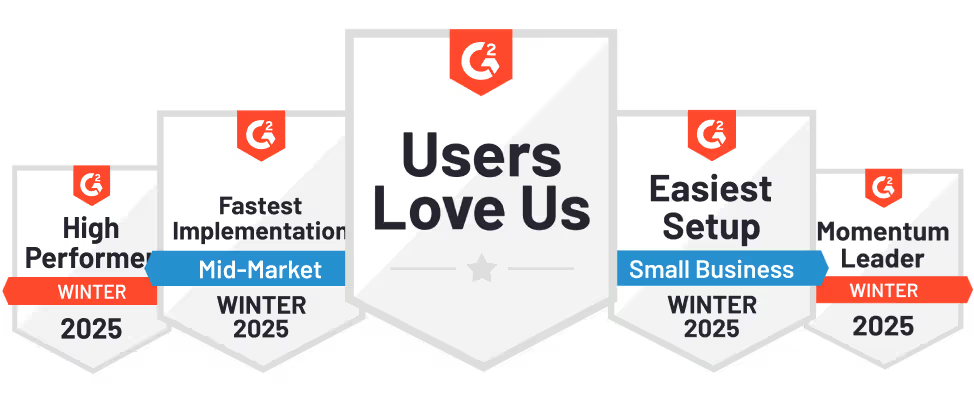
.svg)